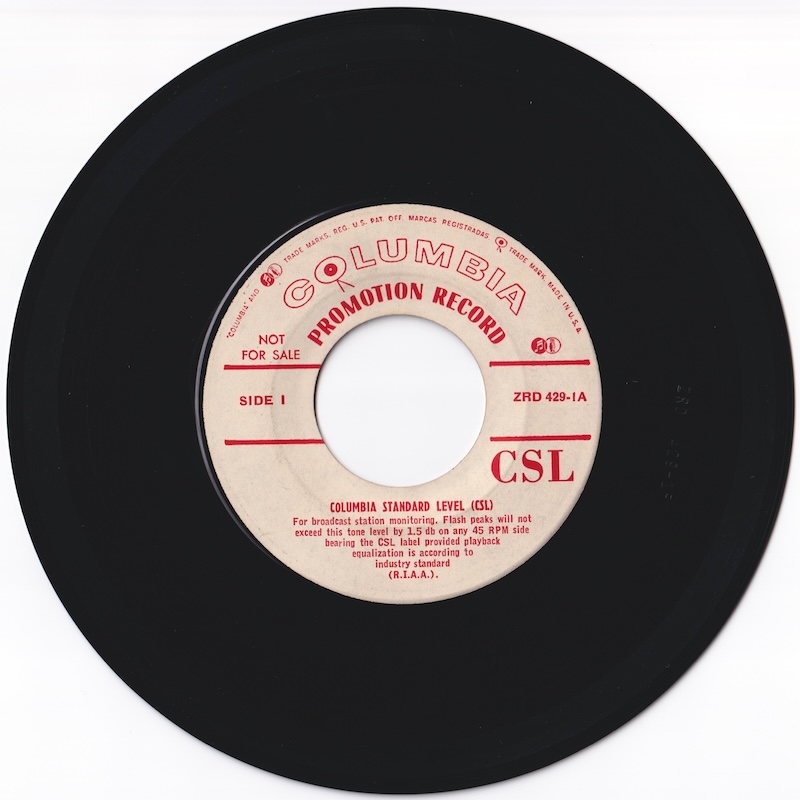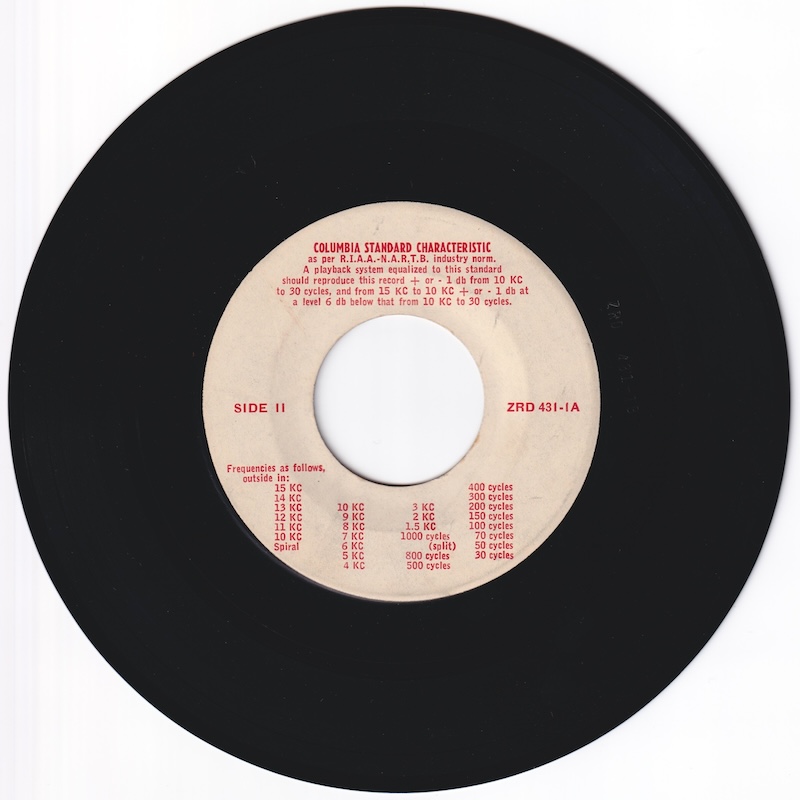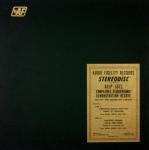EQカーブの歴史、ディスク録音の歴史を学ぶ本シリーズ。前回 Pt.19 では、1950年代中盤〜1970年代の代表的なカッティングアンプと内蔵録音フォノイコの取説や回路図を調査し、どのように RIAA 録音カーブが実現されていたかを学びました。
On the previous part 19, I learned how the RIAA recording curve was accomplished with various recording amplifiers and built-in recording EQs from the mid-1950s to 1970s.
今回の Pt.20 では、1954年前半に RIAA 録音再生特性の標準規格化が策定されたあと、米国の各レーベルがどのように RIAA に移行していったか、その痕跡を探すと同時に、過去〜現在における EQ カーブ調査の系譜についてもみていきます。
In this Pt. 20, we’re going to look for traces of how the U.S. labels migrated to RIAA, after the standardization of RIAA Recording and Reproducing Standards in early 1954, as well as to examine the genealogy of the studies and researches on EQ curves, from past to the present.
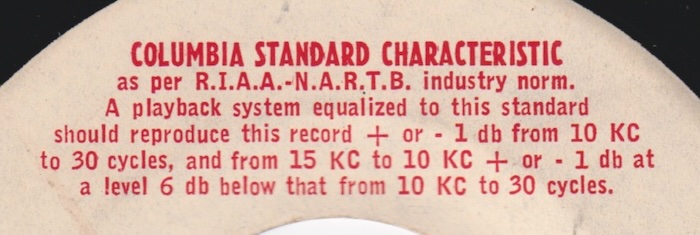
SIDE II, ZRD 431-1A (from my own collection)
COLUMBIA STANDARD CHARACTERISTIC as per R.I.A.A. — N.A.R.T.B. industry norm.
A playback system equalized to this standard should reproduce this record ± 1 db from 10 KC to 30 cycles, and from 15 KC to 10 KC ± 1 db at 6 db below that from 10 KC to 30 cycles.
毎回書いている通り、筆者自身の学習過程を記したものですので、間違いの指摘や異論は遠慮なくお寄せください。
As I noted in every part of my article, this is a series of the footsteps of my own learning process, so please let me know if you find any mistakes on my article(s) / if you have different opinions.
いつものように長くなってしまいましたので、さきに要約を掲載します。同じ内容は最後の まとめ にも掲載しています。
Again, this article become very lengthy — so here is the summary of this article beforehand (the same summary are avilable also in the the summary subsection).
RIAA規格策定前に、RIAAと同一録音特性を使っていたレーベルは、RCA Victor、Capitol、そして両者に製造委託していたマイナーレーベルだけだった。
Prior to the establishment of the RIAA Standard, the only labels that used the same recording characteristics as RIAA were, RCA Victor, Capitol and minor labels that outsourced their production to RCA and/or Capitol.
1954年8月時点で、Columbia では RIAA への変更が済んだスタジオ設備は全体の半数以下で、全設備の移行完了はそこからまだ半年以上かかる、とニュース記事が伝えていた。
As of August 1954, only less than half of Columbia’s studio facilities had been converted to RIAA, and it would take another six months or more before the entire transition was complete, according to the news article.
唯一、Westminster レーベルだけが、RIAA へ移行せず、旧NABカーブのままでいく、と1954年8月時点で同記事中で明言していた。
Only the Westminster label stated in the same news as of Aug. 1954 that it would not move to the RIAA and would remain on the old NAB curve.
Rudy Van Gelder 氏本人が「自分は RIAA 特性を使用している」と発言している、1955年10月の寄稿記事がある。使用機材からも説明できる。
There is a contributed article from October 1955 in which Rudy Van Gelder himself states that he uses the RIAA characteristics. The equipment he used proves this.
現在、さまざまなEQカーブ一覧表の情報が流通しているが、信頼できるものは「過去の論文や技術資料を参照している」「出典を明らかにしている」「過去の一覧表を比較しながら横断的に分析している」などの特徴があると考える。
Currently, variations on EQ curve listing are circulating, but I believe that reliable ones are characterized by “referencing past papers and technical documents”, “clarifying the source”, and “cross analysis by comparing past listings”.
実際に各録音で使用された録音EQカーブが完璧に特定できない以上、さまざまな客観的情報や論理的整合性に基づいた推論をもとに、個々人が探究していくしかない。
Since the actual recording EQ curves used in each recording cannot be perfectly identified, it is up to each individual to explore them based on various objective information and inferences based on logical consistency.
同時に、個々人が思い思いのカーブで再生することは自由である(それが客観的に正しいカーブでなかったとしても)。
At the same time, each individual is free to play with the curves as he/she sees fit (even if the curve selected is not objectively correct).
Contents / 目次
- 20.1 Toward The Uniform Equalization Since 1954
- 20.1.1 RCA Victor and Capitol: using RIAA before 1954
- 20.1.2 When each non-RIAA labels switched to RIAA? (tentative draft)
- 20.1.3 “After Five Years: Uniform Equalization” (High Fidelity, March 1954)
- 20.1.4 “The Curve That Conforms” (Radio & Television News, July 1954)
- 20.1.5 “CURVE UNIFORMITY AIN’T: Diskeries Still Hold Out Against RIAA Standards” (The Billboard, August 28, 1954)
- 20.1.6 Columbia’s “CSL” and “Columbia Standard Characteristic” (RIAA)
- 20.1.7 “How Quality Of Old Discs Is Brought Up In Standard” (Down Beat, Oct. 19, 1955)
- 20.1.8 “Certified Record Revue” by Bert Whyte (Radio & Television News, from Sep. 1953 to Jan. 1960)
- 20.1.8 Listening in Depth: An Introduction to Columbia Stereophonic Sound
- 20.1.9 Few objective data survives and/or being public
- 20.2 Learning the Various Sources of “EQ CURVES”
- 20.2.1 Notable Resources (1): “Audiophile’s Guide to Phonorecord Playback Equalizer Settings” by James R. Powell, Jr.
- 20.2.2 Notable Resources (2): MidiMagic
- 20.2.3 Notable Resources (3): PsPatial
- 20.2.4 Notable Resources (4): Esoteric Sound Rek-O-Kut Re-Equalizer III Operating Manual
- 20.2.5 Notable Resources (5): Audacity Plugins
- 20.3 Meta-analysis of past/present resources is needed (preface to Pt. 21)
- 20.4 The summary of what I got this time / 自分なりのまとめ
20.1 Toward The Uniform Equalization Since 1954
さて、RIAA 規格成立直後の 1954年2月1日の時点で、マスタリング(カッティング)現場ですでに RIAA 録音カーブを使用していたことが確実なのは、以下のレーベルとなります。
It is known that, as of February 1, 1954 (just after the formulation of the RIAA Standard), the following labels were already using the RIAA recording characteristics for mastering (cutting) discs.
20.1.1 RCA Victor and Capitol: using RIAA before 1954
まず RCA Victor、およびその傍系レーベルである “X”、さらに廉価版レーベル Camden などです。Pt.17 セクション 17.5.2 ですでに見たように、1952年8月以降リリースの盤は、New Orthophonic 特性、すなわち RIAA 録音カーブでカッティングされています。それ以前の (old) Orthophonic 特性でカッティングされたスタンパーでプレスされた旧譜も、1952年8月以降にリカッティングされたものは、New Orthophonic に切り替わっていったことになります。
Firstly, RCA Victor and its subsidiary “X”, and its budget label Camden already used the RIAA recording characteristic. As we have already learned in the Pt.17 Section 17.5.2, the discs initially released after August 1952 were cut with RCA Victor’s New Orthophonic characteristic, which later was adopted as the RIAA recording characteristic. Older recordings pressed using stampers cut with earlier (old) Orthophonic characteristic were also switched to New Orthophonic when they were recut after August 1952.
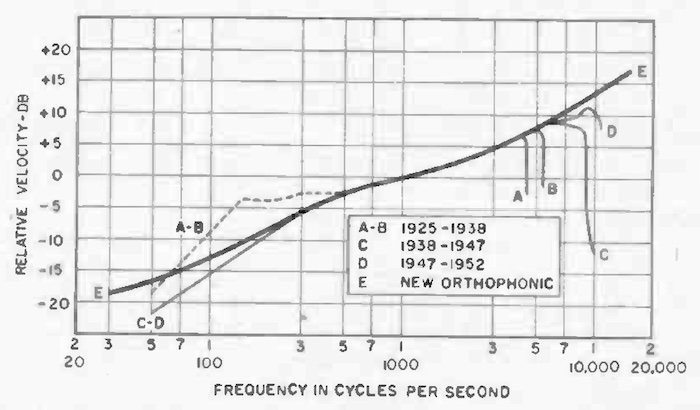
source: “Evolution of a Recording Curve”, R.C. Moyer, Audio Engineering, Vol. 37, No. 7, July 1953, p. 20.
D がいわゆる Old Orthophonic、E が New Orthophonic = RIAA
そして、RCA Victor にマスタリングおよびプレス委託をしていた(=テープを送付し、カッティング以降を RCA に委託していた)独立系レーベルも、これに準ずることになります。Pt.17 セクション 17.5.2 や セクション 17.6.2 でみたように、Urania、Westminster、Philharmonia、Esoteric などのレーベルがそれに該当します。他にも RCA に製造委託していたマイナーレーベルはたくさんあったはずです。
This also applies to independent labels that outsourced mastering and pressing to RCA Victor (i.e. sent tapes to RCA and outsourced the cutting process and beyond). As previously mentioned in Pt.17 Section 17.5.2 and Section 17.6.2, labels such as Urania, Westminster, Philharmonia, Esoteric etc. fall into this category. There must have been many other minor labels that were outsourced to RCA.
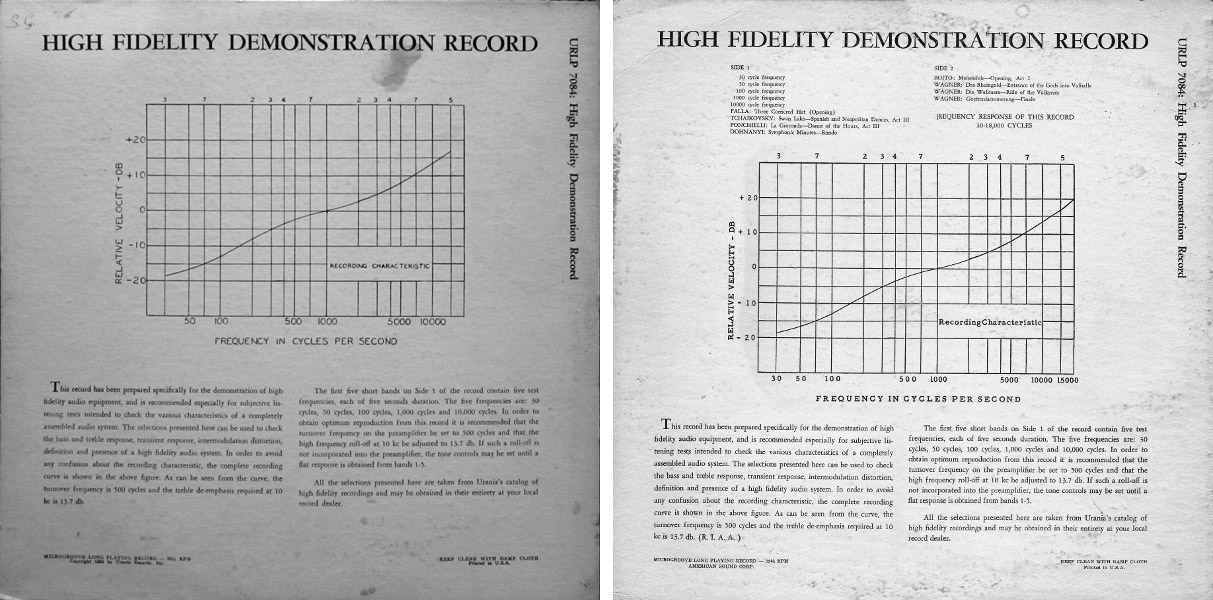
Back covers of Urania URLP-7084
Left: 1st pressing (photo from Discogs entry)
Right: 2nd pressing (photo from Discogs entry)
Urania URLP-7084 (1953) の裏ジャケ。左が1stジャケ、右が2ndジャケ。)
ただし、これらのレーベルは、すべてのリリースを RCA Victor に製造委託していたわけではないので、あくまで RCA Victor 委託分のみが該当 することになります。特に Westminster の多くは、XTV マトリクスからも分かる通り、Columbia にテープを送付しマスタリングおよびプレスを委託していました。このように、RIAA 統一前は、マイナーレーベルでは複数の委託先を使っていたため、同じレーベルでも盤によって異なる録音特性が使われていたケースもあったようです。
However, not all of these labels did not outsourced all of their releases exclusively to RCA Victor. So only the releases that were outsourced to RCA are relevant here. In particular, many of Westminster’s releases were sent to Columbia for mastering and pressing, as indicated by the XTV matrix. Therefore, as many minor labels used multiple outsourcing facilities, it sometimes happened that different recording characteristics were used for different releases even on the same label, before the unification of the RIAA.
続いて Capitol も、1953年秋頃から New Orthophonic と同等の録音カーブでカッティングしていたので、すでに RIAA 録音カーブとの使用が開始されていたことになります。Pt.17 セクション 17.5.3 でみたように、1953年10月頃には New Orthophonic でカッティングされた LP のリリースが確認されているので、そこから徐々に新譜やリカッティングでは New Orthophonic = RIAA 録音カーブが適用されていったことになります。
Capitol also started using the same curve as RCA Victor’s New Orthophonic in the fall of 1953, which means that they had already started using the RIAA recording curve. As discussed in Pt.17 Section 17.5.3, the New Orthophonic = RIAA recording curve was gradually applied to new releases and recuttings from that point on.
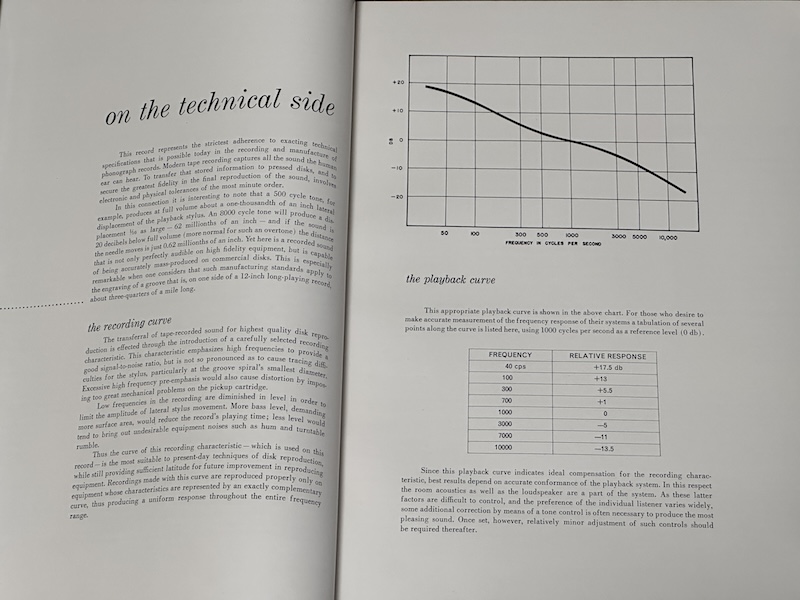
(from my own collection)
1953年秋にリリースされた、Capitol SAL-9020 のブックレットより。New Orthophonic = RIAA とほぼ同じ再生特性がプロットされている。
Capitol の新規カッティングが RIAA に完全移行したのがいつ頃なのか、議論の余地がまだあるかもしれませんが、1954年中には移行完了していたと考えられます。
Although there may still be room for debate as to when Capitol’s new cuttings were fully transitioned to RIAA, but it is believed that the transition was completed by the end of 1954 at the latest.
そして、Capitol にマスタリングおよびプレス委託をしていた(=テープを送付し、カッティング以降を Capitol に委託していた)独立系レーベルも、これに準ずることになります。
This also applies to independent labels that oursourced mastering and pressing to Capitol (i.e. sent tapes to Capitol for cutting and beyond).
たとえば、Pt.17 セクション 17.5.6 でみたように、Contemporary および Good Time Jazz レーベルは、初期は Charles Eckart Company に委託、のちに Capitol に委託していた(Roy DuNann 氏が 1956年に Capitol から Contemporary に移籍するまで)ことが知られていますので、Capitol に準じて 1953年秋頃には New Orthophonic = RIAA 録音カーブでカッティングされていたことになります。
For example, as mentioned in Pt.17 Section 17.5.6, Contemporary and Good Time Jazz labels were initially outsourced to the Charles Eckart Company, and later to Capitol (until Roy DuNann moved from Capitol to Contemporary in 1956). Therefore, the recordings were cut using the New Orthophonic = RIAA recording curve in the fall of 1953.
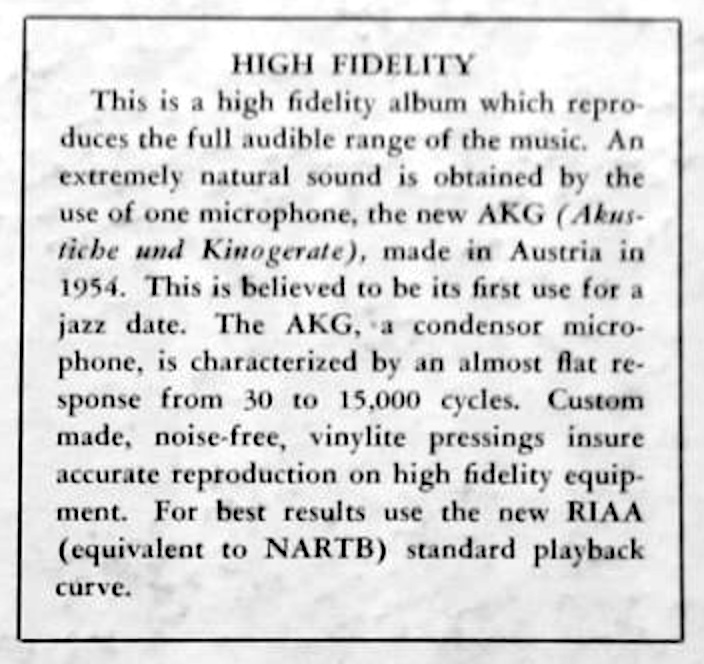
from the back cover of “Lennie Niehaus Vol.1: The Quintet” (Contemporary C-2513)
“For best results use the new RIAA (equivalent to NARTB) standard playback curve”
この10インチLPのマトリクスの特徴から、Capitol Los Angeles プラント製造であることが分かる
この盤は、当時 Capitol エンジニアだった Roy DuNann ではなく、同じく Capitol の John Palladino マスタリングのようです
Matrix stamps indicate this 10-inch LP was manufactured at Capitol’s Los Angeles plant.
It is known that John Palladino of Capitol was responsible for mastering this particular record.
これらのレーベル以外は、1954年2月時点では、New Orthophonic = RIAA「以外」の録音カーブを適用してカッティングしたレコードを出していたことになります(詳細は Pt.17 を参照)。
All but these labels (that would have issued records cut with the New Orthophonic = RIAA) used “non-RIAA” recording curves (see Pt.17 for details) as of February 1954.
20.1.2 When each non-RIAA labels switched to RIAA? (tentative draft)
上記以外のレーベルが RIAA と同等の録音カーブにいつ移行した(とされている)のか、一部ですが代表的な情報をまとめてみました。
The following is a partial but representative list of information on when labels other than those listed above moved (or are believed to have moved) to a recording curve equivalent to that of the RIAA.
Columbia は 1954年から徐々に RIAA への移行を進めていたようですが、後述する通り1955年後半になるまで移行が完了していなかったようです。ですので、この時期は、新譜であっても、Columbia LP カーブと RIAA カーブの両方が混在していたようです。既に Columbia LP カーブでカッティングされたマスターやスタンパーが使えなくなるまでは RIAA で再カットされなかったでしょうから、Columbia LP カーブでカッティングされた盤が実際に流通していたのは意外と長かった可能性もあります。また、Concert Hall、Urania、Vanguard、Vox、Westminster など、 Columbia に委託していたレーベルも(Columbia 委託分は)これに準じることになります。
Columbia seems to have been gradually transitioning to RIAA starting from 1954, but as I will be describing below, the transition was presumably not completed until late 1955. Therefore, during this period, both Columbia LP curve and RIAA curve were mixed even for new releases. Also, masters and stampers already cut with Columbia LP curve were not recut with RIAA, until they were no longer available, so it is possible that the actual distrobution of Columbia LPs cut with the Columbia LP curve was surprisingly long. Also, such labels including Concert Hall, Urania, Vanguard, Vox, Westminster, that outsourced to Columbia would all have followed suit (as long as the particular discs were outsourced to Columbia).
MGM は、はっきりした情報が見つけられていません。1952年(すなわち RCA Victor が New Orthophonic を導入した年)に RIAA に移行済、という説もあるようですが、1954年後半頃には RIAA への移行を完了させていたという説が主流のようです。
I have not been able to find any definitive information on MGM. Some say that they had already converted to RIAA in 1952 (i.e. the year RCA Victor introduced New Orthophonic), but the prevailing theory seems to be that they had completed their conversion to RIAA by late 1954.
米Decca は比較的遅かったと言われており、1955年11月頃まで NAB カーブだった、という説もあるようです。
It is said that (U.S.) Decca‘s transition to RIAA was relatively slow, and some say that they were using NAB curve until around November 1955.
Blue Note や Prestige の録音およびカッティングを行っていた Rudy Van Gelder のスタジオでは、1955年初頭には RIAA 録音 EQ を使った機材に置き換えていることが知られています(Pt.19 参照)。
It is known that Rudy Van Gelder‘s Studio, where he recorded and cut for Blue Note, Prestige, etc. replaced its recording equipment with that utilizing RIAA recording EQs in early 1955 (see: Pt.19).
Atlantic は、ジャケット裏表記を信用するならば、1955年までには RIAA に切り替えていたことになります。
Atlantic had switched to RIAA by 1955, if we trust the notation on the back cover.
米 London レーベルは、英 Decca でカッティング・プレスされ、米国に輸入され販売されていたので、英 Decca の事情に準じます。「ffrr」(Full Frequency Range Recording) と銘打たれた英 Decca のマイクログルーヴLPでは、3種類の録音カーブが使用されていたことが研究で明らかとなっており(“Manual of Analogue Sound Restoration Techniques” by Peter Copeland, 2008)、時期によって (1) 500N-FLAT (318μs)、(2) 500N-10.5 (318μs, 50μs)、(3) 500R-13.7 (3,180μs, 318μs, 75μs) と変化します。このうち (3) の 500R-13.7 すなわち RIAA と同一録音特性にスイッチしたのは、マトリクス番号 ARL2539 以降と言われています。ちなみに ARL2539 は London LL.1245 (1954) という盤です。
Releases by London were cut and pressed by (U.K.) Decca, and imported to the U.S. for sale. So the situation is the same as that of U.K. Decca. Research has shown that U.K. Decca’s microgroove LPs — labelled “ffrr” (Full Frequency Range Recording) — used three different recording curves at different times (“Manual of Analogue Sound Restoration Techniques” by Peter Copeland, 2008), and these curves were: (1) 500N-FLAT (318μs); (2) 500N-10.5 (318μs, 50μs); and (3) 500R-13.7 (3,180μs, 318μs, 75μs). Of these, the switch to (3) 500R-13.7 (i.e., the same characteristic as RIAA’s), is said to have been made after the matrix number ARL2539, which was used for London LL.1245 (1954).
そして、一部のマイナーレーベルでは旧機材で独自マスタリング(カッティング)を継続、45-45 ステレオ LP が登場する1958年に至るまで RIAA 移行を行わなかった、という説もあるようです。
Some minor labels continued their own mastering (cutting) using the old equipment, and some say that they did not make the transition to RIAA until 1958, when the 45-45 stereophonic records were released.
以上、最終結論ではなく、以下を読み進める上での暫定的な仮説(過去のさまざまな情報の集約)として記しました。
Well, the above is not a final conclusion, but rather a tentative hypothesis (an aggregation of various past information) for further reading.
20.1.3 “After Five Years: Uniform Equalization” (High Fidelity, March 1954)
当時の雑誌などが、RIAA 規格策定後の動きをどのように報道していたか、も、別の側面で参考になります。
Another aspect that can be helpful is to examine how magazines and other documents of the time reported on developments after the establishment of the RIAA Recording and Reproducing Standard.
RIAA規格正式承認の1ヶ月後、ハイファイオーディオマニア向け雑誌である High Fidelity 誌1954年3月号 に、ついに録音特性が業界で統一された、と伝える記事「After Five Years: Uniform Equalization」(5年越しでのEQ統一)が掲載されました。その冒頭部分はこう始まります。
One month after the official approval of the RIAA Standards, the March 1954 issue of High Fidelity magazine published an article entitled “After Five Years: Uniform Equalization”, which reported that recording characteristics had finally been standardized in the industry. The article begins as follows:
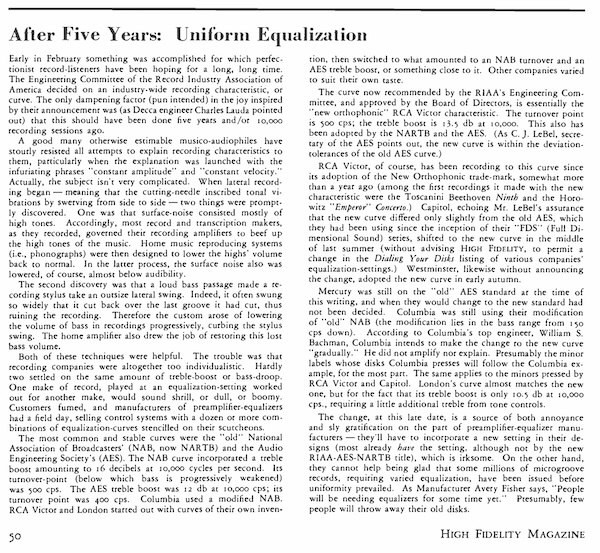
source: High Fidelity, March 1954, p.50.
Early in February something was accomplished for which perfectionist record-listeners have been hoping for a long, long time. The Engineering Committee of the Record Industry Association of America decided on an industry-wide recording characteristic, or curve.
(1954年)2月初旬、完璧主義のレコードリスナーが長らく望んでいた、あることが実現した。全米レコード工業会(RIAA)の技術委員会が、業界全体の録音特性(録音カーブ)を決定したのだ。
The only dampening factor (pun intended) in the joy inspired by their announcement was (as Decca engineer Charles Lauda pointed out) that this should have been done five years and/or 10,000 recording sessions ago.
RIAA の発表を受けた喜ばしい状況をダンピング(減衰、これはダジャレである)する唯一の要因は、Decca のエンジニア Charles Lauda 氏が指摘しているように、この(業界統一カーブの)策定は、5年前、あるいは1万回前のレコーディングセッションの時から行われるべきであった、ということである。
“After Five Years: Uniform Equalization”, High Fidelity, March 1954, p.50.もちろん、本記事に登場する Charles Lauda 氏は、RIAA 録音再生特性をとりまとめた、あの RIAA 技術委員会メンバの1人です(Pt.18 セクション 18.5.5 参照)。
Of course, Charles Lauda, who appears in this article, is one of the members of the RIAA Engineering Committee that formulated the RIAA Recording and Reproducing Characteristics (see: Pt. 18 Section 18.5.5).
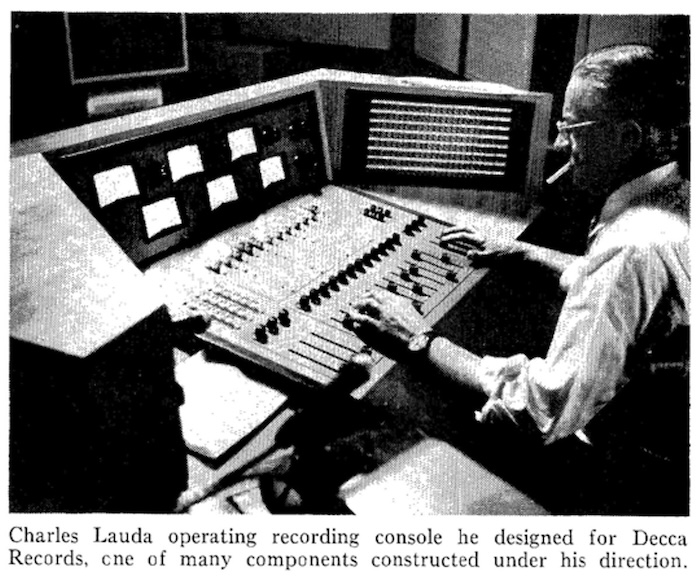
source: Journal of the AES, Jan. 1966, p.96
その後、録音特性の歴史やその変遷について、簡単な説明があったのち、1954年3月時点における米国内各レーベルの対応状況を解説した箇所があります。まず、RCA Victor、Capitol、Westminster から。
After a brief explanation of the history of recording characteisrics and how they had changed over the years, there is a section that describes the corresponding status of each label in the United States as of March 1954. The article first discusses RCA Victor, Capitol and Westminster:
RCA Victor, of course, has been recording to this curve since its adoption of the New Orthophonic trade-mark, somewhat more than a year ago (among the first recordings it made with the new characteristic were the Toscanini Beethoven Ninth and the Horowitz “Emperor” Concerto.)
RCA Victor は、もちろん、1年以上前に New Orthophonic という商標を採用して以来、このカーブに合わせて録音(カッティング)している。ちなみに、この新録音特性で最初にカッティングされたものの中に、トスカニーニのベートーヴェン第9、ホロヴィッツの「皇帝」協奏曲がある。
Capitol, echoing Mr. LeBel’s assurance that the new curve differed only slightly from the old AES, which they had been using since the inception of their “FDS” (Full Dimentional Sound) series, shifted to the new curve in the middle of last summer (without advising HIGH FIDELITY, to permit a change in the Dialing Your Disks listing of various companies’ equalization-settings.)
Capitol は、「FDS」(Full Dimensional Sound」シリーズが始まった時から旧AESカーブを使っていたが、先ほど紹介した LeBel 氏の「新(RIAA)カーブは、旧AESカーブと大きな差分はない」という発言に共鳴するかのように、昨年(1953年)の夏の半ばに新カーブに移行している。(この変更は Dialing Your Disks リストを掲載している当 High Fidelity 誌には伝えられなかった)。
Westminster, likewise without announcing the change, adopted the new curve in early autumn.
同様に Westminster も、変更のアナウンスなしに、昨年秋から新カーブを採用している。
“After Five Years: Uniform Equalization”, High Fidelity, March 1954, p.50.この High Fidelity 誌の記事では、Westminster は 1953年秋から新カーブ(New Orthophonic = RIAA)を使っている、とされていますが、これは記事の間違いでしょう。
This High Fidelity’s article states that Westminster has been using the new curve (New Orthophonic = RIAA) since the fall of 1953, which is probably an error.
なぜなら、続く Radio & Television News 誌の記事中では、Westminster 音楽ディレクタの Kurt List 博士が、「当分の間旧NABカーブを使用する」と答えているからです。また、Discogs 上の Westminster レーベルの全リリースのたとえば1953年以降 を調査すれば分かる通り、ほとんどが XTV マトリクス、つまり、Columbia でマスタリングされプレスされたことが分かるからです。
This is because in a subsequent Radio & Television News’ article, Dr. Kurt List (Westminster musical director) states that “for the time being Westminster would use the old NAB curve”. Also, a study of all Westminster label releases since 1953 on Discogs shows that most titles were mastered and pressed by Columbia, with XTV matrix.
つまり、この High Fidelity 誌の記事の記載とは異なり、Westminster レーベルも、基本的には Columbia レーベルの事情に準じることになります。
In other words, contrary to the description in the High Fidelity article, the Westminster label basically follows the Columbia label’s situation.
「Orthophonic」という商標は、Western Electric / Bell Labs の協力のもと 1925年に発表した、電気録音78回転盤を再生するためのアコースティック蓄音機「Victor Orthophonic Victrola」に由来しており(Pt.1 参照)、当然ながら RCA Victor 以外は使うことができないものでした。なので、New Orthophonic 特性が業界標準の RIAA カーブとなる前は、RCA Victor 以外は「New Orthophonic カーブ」という名称が使えなかったわけです。
The trademark “Orthophonic” was derived from the “Victor Orthophonic Victrola”, an acoustic phonograph introduced in 1925, in cooperation with Western Electric / Bell Labs, to play electrically-recorded 78 rpm records (see: Pt.1). Therefore, before the New Orthophonic characteristic became the RIAA curve as an industry standard, only RCA Victor could use the name “New Orthophonic curve”.
続いて、Mercury、Columbia の状況、および、RCA Victor / Columbia / Capitol に製造委託するレーベルの話、さらに(英 Decca に準じる)米 London レーベルの状況が説明されています。
Next, the article explains the situation of Mercury and Columbia, as well as the situation of the labels that outsource to RCA Victor / Columbia / Capitol, and the situation of the London (that follows U.K. Decca).
Mercury was still on the “old” AES standard at the time of this writing, and when they would change to the new standard had not been decided.
本記事執筆段階では、Mercury はまだ旧AES規格を使っている。新規格への変更がいつ行われるか、は未定である。
Columbia was still using their modification of “old” NAB (the modification lies in the bass range from 150 cps down). According to Columbia’s top engineer, William S. Bachman, Columbia intends to make the change to the new curve “gradually.” He did not amplify nor explain.
Columbia は依然として旧NAB規格を独自改良したもの(旧NABとは150Hz以下のベースシェルフが異なる)を使用している。Columbia のトップエンジニアである William S. Bachman 氏によると、Columbia の新カーブへの移行は「徐々に行うつもり」とのことであるが、彼は強調も説明もしなかった。
Presumably the minor labels whose disks Columbia presses will follow the Columbia example, for the most part. The same applies to the minors pressed by RCA Victor and Capitol.
おそらくは、Columbia に製造・プレス委託をしているマイナーレーベルのほとんども、Columbia の例に従うことになるだろう。RCA Victor や Capitol に製造・プレス委託をしているマイナーレーベルも同様である。
London’s curve almost matches the new one, but for the fact that its treble boost is only 10.5 db at 10,000 cps., requiring a little additional treble from tone controls.
London のカーブは、新(RIAA)カーブとほぼ同じであるが、高域ブーストが 10,000Hz で 10.5dB しかないため、トーンコントロールで若干高域増幅してあげる必要がある。
“After Five Years: Uniform Equalization”, High Fidelity, March 1954, p.50.そして最後に、民生用オーディオ機器メーカにとっての、RIAA特性策定後の動きについて私見が述べられています。特に後半部分の「すでに非RIAAカーブで製造されたレコードが大量に存在していることは、オーディオメーカ的に喜ばしい(可変イコライザ内蔵機器を売ることができる)」というコメントは、いろいろ考えさせられるというか、近年でも似たような状況を目にしますね(笑)
The article concludes with the author’s personal opinion on the developments for consumer audio equipment manufacturers after the RIAA Standard was established. In particular, the comment “they cannot help being glad that some millions of microgroove records, requiring varied equalization, have been issued before uniformity prevailed” makes us think a lot. Ah, we see a very similar situation in recent years anyway 🙂
The change, at this late date, is a source of both annoyance and sly gratification on the part of preamplifier-equalizer manufacturers — they’ll have to incorporate a new setting in their designs (most already have the setting, although not by the new RIAA-AES-NARTB title), which is irksome.
つい最近に行われたこの(業界統一カーブという)変更は、プリアンプやイコライザの機器製造メーカにとっては、悩みの種であると同時に、密かに喜ばしいことである。新カーブの設定を機器設計に取り入れる必要があり(もっとも、新しい「RIAA」「改訂AES」「NARTB」という名前ではないが、すでにこの設定を持っているメーカも多いのだが)、これは煩わしいことである。
On the other hand, they cannot help being glad that some millions of microgroove records, requiring varied equalization, have been issued before uniformity prevailed. As Manufacturer Avery Fisher says, “People will be needing equalizers for some time yet.” Presumably, few people will throw away their old disks.
一方、録音カーブの業界統一前に、さまざまなイコライジングを必要とするマイクログルーヴ盤が何百万枚とリリースされてきたことを(オーディオ機器メーカは)喜ばずにはいられないであろう。機器製造メーカである Avery Fisher が言うように、「人々はまだしばらくの間、イコライザを必要とするであろう」。ほとんどの人はおそらく、古いレコードを捨てることはないだろうから、である。
“After Five Years: Uniform Equalization”, High Fidelity, March 1954, p.50.20.1.4 “The Curve That Conforms” (Radio & Television News, July 1954)
上の High Fidelity 誌の数ヶ月後に発行された Radio & Television News 誌1954年7月号 には、米レコード業界で録音再生カーブが統一されたことを概説する記事「The Curve That Conforms」(統一されたカーブ)が掲載されました。
The July 1954 issue of Radio & Television News magazine, published a few months after the High Fidelity above, contained an article entitled “The Curve That Conforms”, which outlined the unification of the recording / reproducing curves.
この記事が貴重なのは、末尾に1954年6月当時のメジャーレーベルに直接ヒアリングして得られた回答が掲載されているからです。
What makes this article valuable is that at the end it contains the answers obtained through direct interviews with the major labels at that time in June 1954.
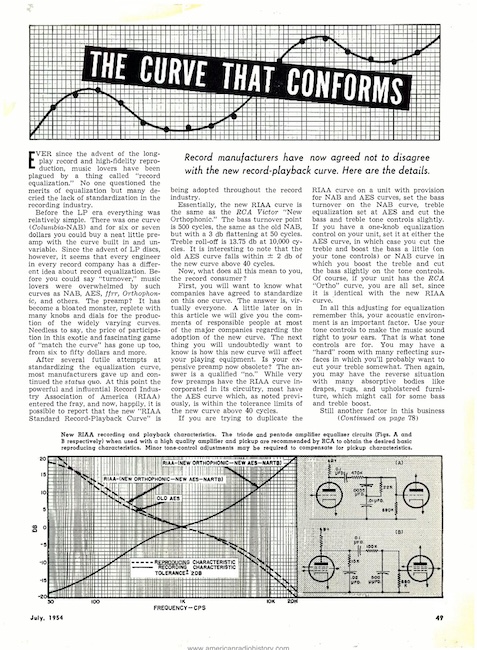
source: Radio & Television News, July 1954, pp.49 & 78.
まずは RCA Victor から。当時のチーフエンジニア Albert Pulley 氏が自信たっぷりに回答しています。
The first one is from RCA Victor. Mr. Albert Pulley, chief engineer at that time, answers confidently.
Now, let’s hear from the industry about the new curve:
ではここで、新カーブに関して、レコード業界からの声を聞いてみることにしよう。
Albert Pulley (Chief Engineer, RCA Victor) — “Of course the new curve is identical with our “Orthophonic” which we have been using for some time now.” (Incidentally Mr. Pulley pointed out that Victor Records marked “New Orthophonic” on their jackets are not merely cut with the new curve, but are so designated because of all the other factors such as microphoning, etc., which part of the “New Orthophonic” process”). All other new Victor records are cut with the new RIAA curve whether or not they state “Orthophonic” on the jackets. Mr. Pulley also asserted that all replacements and even the “Treasury” series would be cut with the RIAA curve whenever possible.
Albert Pulley (RCA Victor チーフエンジニア) — 「もちろん新カーブは、我々が以前から使っている Orthophonic と全く同じものだ」(ちなみに Pulley 氏は、レコードジャケットに “New Orthophonic” と記されているのは、単に録音カーブのことだけを意味するのではなく、マイクなどさまざまな要因を含めた “New Orthophonic” というプロセスを指すのだ、と指摘した)。そしてジャケットに “Orthophonic” と書かれていようがいまいが、全ての Victor の盤は新しい RIAA カーブでカッティングされている。また Pulley 氏は、今後の再プレスや旧音源再発においてもすべて、可能な限りRIAAカーブでカッティングする、と断言した。
“The Curve That Conforms”, Radio & Television News, July 1954, pp.49 & 78.続いて、さきほどの2月時点では「RIAAへの移行は徐々に行うつもり」と書かれていた Columbia は、William S. Bachman 氏によるコメントです。上の RCA Victor に比べると若干歯切れが悪いのには理由がありそうです(後述)。
Next is Columbia. Mr. William S. Bachman, who answered “intends to make the change to the new curve gradually” as of Feb. 1954, comments as below. There seems to be a reason why his comment is a little less clear than that of RCA Victor (will be discussed later).
William Bachman (Chief Recording Engineer, Columbia) — “We are using the new RIAA curve in all new Columbia recordings. All replacements will be cut with the RIAA curve whenever possible.”
William Bachman (Columbia チーフ録音エンジニア) — 「我々は、Columbia の新録音では、RIAA カーブを使用している。既発盤の再プレスは全て、可能な限りRIAAカーブでカッティングする。」
“The Curve That Conforms”, Radio & Television News, July 1954, pp.49 & 78.お次は Mercury で、Fine Sound Studios 代表の C. Robert Fine 氏が簡潔に回答しています。ここでは触れられていませんが、Mercury が RIAA 録音規格に移行したのは 1954年秋頃から、と言われています。また、Pt.18 でも書きましたが、Fine 氏は Mercury の社員ではなく、社外技術コンサルタントのような立場で Mercury に関わっていたのですが、このような技術的な話の時には常に Mercury を代表してまるで社員のように対応していました。
Next is Mercury, with a brief comment from Mr. C. Robert Fine (president of Fine Sound Studios). Although not mentioned here, it is said that Mercury’s transition from AES to RIAA began in the fall of 1954. Also, as I mentioned in the Pt.18, Mr Fine was not an employee of Mercury, but was involved with Mercury as an outside technical consultant. He always represented Mercury as if he were an employee when discussing such technical matters.
C. Robert Fine (Chief Engineer, Mercury Records) — Mr. Fine indicated that Mercury would go along with the industry in using the RIAA curve in all new releases.
C. Robert Fine (Mercury チーフエンジニア) — Fine 氏の指摘では、Mercury は RIAA カーブを使用する業界の流れに従うことになるだろう、とのことである。
“The Curve That Conforms”, Radio & Television News, July 1954, pp.49 & 78.続いて London (すなわち英 Decca)は A&R ディレクタの Remy van Wyck Farkas 氏のコメントです。さきほど上でみた High Fidelity 誌 1954年3月号の記事(つまり1954年2月時点での状況)では、まだ RIAA カーブに移行していないとされていましたが、この記事(1954年6月時点での状況)では、RIAAカーブへの移行が済んだとされており、London(英 Decca)は1954年前半に RIAA へ移行したことになります。
Following is London (i.e. U.K. Decca), with the comment by Remy van Wyck Farkas, Director of A&R. The article in the Mar. 1954 issue of High Fidelity (thus the situation as of Feb. 1954) states that the transition RIAA had not yet been completed. However, this article (as of Jun. 1954) states that the transition to RIAA was completed, which means that London (U.K. Decca) transitioned to RIAA in the first half of 1954.
Remy van Wyck Farkas (Director of Artists and Repertoire, London) – “We have been using the RIAA curve for some months now. Our entire catalogue will be recut with the RIAA curve as soon as stocks of the records with the older curve become depleted.”
Remy van Wyck Farkas (London A&R ディレクタ) — 「数ヶ月前から RIAA カーブを使用している。古いカーブのレコードの在庫がなくなり次第、全カタログを RIAA カーブでリカットしていく予定だ。」
“The Curve That Conforms”, Radio & Television News, July 1954, pp.49 & 78.そして最後に、直接の回答ではないものの、Capitol、米 Decca、MGM、および大手に製造委託をしているマイナーレーベルについて触れられたのち、非RIAAカーブの継続使用を明言している Westminster の話がつづられます。
Finally, although not in direct response, Capitol, U.S. Decca, MGM, and minor labels that have outsourced to major companies are mentioned. Then it contines with Westminster, which has stated its intention to continue using non-RIAA curve.
Capitol has been using the RIAA curve for some time now. Decca and MGM will use the new curve in future releases. All of the smaller companies whose output is pressed by Columbia and Victor will use the new curve.
Capitol は以前から RIAA カーブを使用している。Decca と MGM は今後のリリースで新カーブを使うだろう。Columbia や Victor に製造委託をしている小規模レーベルは、(Columbia や Victor に準じて)全て新しいカーブが使われることになるだろう。
Notable exception to the almost solid swing to the RIAA curve is Westminster. Dr. Kurt List stated that for the time being Westminster would use the old NAB curve. Dr. List did not elaborate as to why this should be, but you can be sure Westminster has a valid reason, and we predict that they will hop on the RIAA bandwagon before too long.
RIAAカーブへの確実な移行が行われる中、特筆すべき例外として Westminster レーベルが挙げられる。Kurt List 博士によると、Westminster は当分の間、旧 NAB カーブを使用する、とのことである。その理由について List 博士から詳しい説明はなかったが、Westminster がそうするには正当な理由があるのだろうし、そしてそう遠くないうちに Westminster も RIAA に乗り換えるであろう、と我々は予測している。
“The Curve That Conforms”, Radio & Television News, July 1954, pp.49 & 78.Pt.17 や本稿冒頭で書いた通り、1954年当時の Westminster は Columbia にテープを送付し、マスタリング(カッティング)およびプレスを委託していました。よって「当分の間、旧NABカーブを使用」というのは、厳密には「Columbia LP カーブ」であり、また Columbia の移行事情に準じるわけです。
As mentioned in Pt.17 and the beginning of this Pt.20, Westminster sent the tapes to Columbia and outsourced the mastering (cutting) and pressing to Columbia. Therefore, “for the time being Westminster would use the old NAB curve” would strictly be “Columbia LP curve”, and is in accordance with Columbia’s transition situation.
一方、次のセクションで書く通り、Columbia の RIAA 移行は少なくとも1年間をかけて徐々に行われていったようです。つまり、Columbia の自社制作盤用のマスタリング機材から優先して RIAA へとスイッチしていき、委託製造用のマスタリング機材はあとまわしになっていたのかもしれません(推測)。
On the other hand, as we will see in the next section, Columbia’s transition to RIAA seems to have been gradual, taking at least one year to complete. In other words, the switch to RIAA may have been made with priority given to mastering equipment used for Columbia’s own productions, and the mastering equipment used for outsourced productions were left until later (it’s just my guess).
20.1.5 “CURVE UNIFORMITY AIN’T: Diskeries Still Hold Out Against RIAA Standards” (The Billboard, August 28, 1954)
順風満帆なRIAAへの移行を伝える各紙に対し、The Billboard 誌 1954年8月28日号 に掲載された記事「CURVE UNIFORMITY AIN’T: Diskeries Still Hold Out Against RIAA Standards」(カーブ統一はまだならず:RIAA標準規格に抵抗するレーベル)では、RIAA への切り替えを済ませていないレーベルの存在を若干煽り気味に紹介しています。
In contrast to the smooth sailing of the RIAA transition, an article in the August 28, 1954 issue of The Billboard, “CURVE UNIFORMITY AIN’T: Diskeries Still Hold Out Against RIAA Standards” was somewhat incendiary, noting that some labels had not yet made the switch to RIAA Standards.
ただし、「RIAAに抵抗する」という煽情的なタイトルとは裏腹に、その内容は「まだRIAAへの移行が済んでいない」という淡々としたものです。
However, despite the incendiary title “Hold Out Against RIAA”, its content is bland: “The transition to the RIAA has not yet been completed”.
NEW YORK, Aug. 21. — Many months have passed since the Record Industry Association of America, in a splurge of technical unanimity, adopted a uniform recording curve, but some domestic diskeries have yet to switch to its characteristics.
ニューヨーク、8月21日付 — 全米レコード工業会 (RIAA) が、技術的な一致をはかり、統一録音カーブを採用してから何ヶ月も経過したが、一部の国内レコードメーカはまだその特性への変更を済ませていない。
“CURVE UNIFORMITY AIN'T: Diskeries Still Hold Out Against RIAA Standards”, The Billboard, August 28 1954, p.62.そして、セクション 20.1.3 の「After Five Years: Uniform Equalization」でも言及されていたように、カーブの乱立によってオーディオ機器メーカがたなぼたの大儲けとなっている、と皮肉気味に書いています。
And, as mentioned in the Section 20.1.3 “After Five Years: Uniform Equalization”, the article writes sarcastically that the wildly varying curves have resulted in a windfall for audio equipment manufacturers.
Use of different recording curves in the cutting of masters since the development of LP has proven a bonanza for high fidelity equipment manufacturers, who have thrived on the design and promotion of ever more variable control and compensating units. A uniform RIAA curve was to settle all that.
LP登場以降、レコード製造時のマスターカッティング時に、独自の録音カーブを使うレーベルが乱立したことで、高性能オーディオ機器製造メーカにとっては「棚から牡丹餅」状態がもたらされた。さまざまなカーブに対応するためにカーブを可変調整したり補正したりする機能を搭載し、それをセールスポイントとして宣伝することで市場が成長してきたからである。統一されたRIAAカーブの導入によって、この混乱をおさめる、というわけである。
“CURVE UNIFORMITY AIN'T: Diskeries Still Hold Out Against RIAA Standards”, The Billboard, August 28 1954, p.62.そして、貴重な客観的状況が語られます。Columbia の全マスタリング機材のうち、(1954年8月時点では)RIAA への移行を済ませたのは半分にも満たない、という記述です。これは、Columbia の関係者への取材によるものでしょう。
THen comes a valuable objective statement: less than half of Columbia’s total mastering equipment had been converted to RIAA (as of August 1954). This may be based on interviews with Columbia staffs.
Among the majors, Columbia so far has adjusted less than half its equipment to the RIAA stand- ard. Some LP’s still go to market cut on the old Columbia standard, some on the RIAA. Full conversion at the diskery is still some six months away.
メジャーレーベルの中では、Columbia は、RIAA標準に合わせた機材設定が済んだのは現時点では半数に満たないため、従来の Columbia カーブで製造されたレコードも市場に出回り、同時にRIAAカーブで製造されたレコードも市場に出回っている。Columbia の全製造機材においてRIAAカーブへの変更が完了するのは、まだ半年も先のことという。
“CURVE UNIFORMITY AIN'T: Diskeries Still Hold Out Against RIAA Standards”, The Billboard, August 28 1954, p.62.RIAA 規格を策定した5大レーベルのエンジニア(Pt.18 セクション 18.5.5 参照)に Columbia の Bachman 氏がいたことから分かるように、Columbia は RCA Victor、Decca、Capitol、Mercury と共に業界を主導して RIAA カーブを普及させる立場にあったものの、全米の全ての Columbia マスタリングスタジオの機材を RIAA カーブに対応させるのに時間がかかっていた、ということになります。
As evidenced by the fact that Mr. Bachman of Columbia was among the engineers from five major labels that developed the RIAA Standard (see: Pt.18 Section 18.5.5), Columbia, along with RCA Victor, Decca, Capitol and Mercury, led the industry in promoting the RIAA curve. However, it took time to get the equipment in all Columbia mastering studios in the U.S. ready for the RIAA curve.
最後に、現場エンジニアの声と共に、「いずれにせよ近い将来に統一されるだろう」という見通しが記されています。ここでも、現場エンジニアの声として、「録音カーブの違いよりも、マイク配置やスタジオアコースティックの方が音の変化が大きい」という、Audio Engineering 誌で何度も力説されていた話が紹介されています。
The article concludes with the prospect of unification in the near future, one way or another, along with the voice of the engineers in the field: “Microphone placement and studio acoustics make more difference to the sound than the selection of recording curves”, which has repeately emphasized in Audio Engineering magazine.
Engineers who mull the situation daily, tho, rate slight differences in recording curves little more than a token problem. Acoustical differences in recording studios can vary the response much more than use of a non-RIAA curve, they point out.
この日々の状況に頭を悩ませ格闘しているエンジニア達は、次のように評している、録音カーブの些細な変更なんて、単なる「名目や象徴」(token) 以上のものではなく、録音スタジオのアコースティック特性の違いの方が、非RIAA録音カーブの使用による微妙な違いに比べて、出てくる音の変化としてより現れるのだ、と。
One thing all agree upon. When all companies groove their masters according to the same curve, fancy compensators will join the hand wound phonograph in limbo and two dials will drop off phonograph panels.
さておき、全てのエンジニアが同意する真理がここにある。全てのレーベルが同じカーブでレコードを製造するようになった暁には、今後が不安視されている手回し蓄音機にまともなカーブ補正機が導入され、プリアンプのフォノカーブダイヤル2つが撤廃されることになるだろう。
“CURVE UNIFORMITY AIN'T: Diskeries Still Hold Out Against RIAA Standards”, The Billboard, August 28 1954, p.62.手回し(アコースティック)蓄音機のカーブ補正機器の話は、さすがに無茶苦茶でしょうね(笑)
It would indeed be absurd to talk about a curve correction device for a hand-wound (acoustic) phonograph 🙂
20.1.6 Columbia’s “CSL” and “Columbia Standard Characteristic” (RIAA)
1955年2月より、Columbia が、ラジオ放送局向けに独自の社内基準に基づいたリリースを行なっていました。CSL (Columbia Standard Level) と銘打ったシステムに沿った45回転盤です。
From February 1955, Columbia began releasing discs to radio stations, based on their own internal technical standards. They are 45 rpm records based on the system called CSL (Columbia Standard Level).
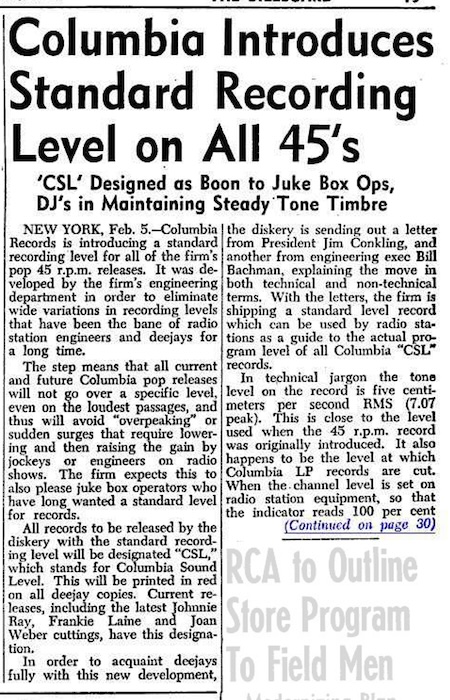
source: “Columbia Introduces Standard Recording Level on All 45’s”, The Billboard, Feb. 12, 1955, p.19
コンプレッサで音量を整えられた45回転盤にする、というニュース。ラジオ局にはプロモ盤のほか、社長の Jim Conkling 氏、およびチーフエンジニア Bill Bachman 氏からの手紙が送付される、とある。
p.30 では、Columbia が射出成型によるポリスチレン45回転盤の組成品質を向上した、とも。
この CSL は、ラジオ局やジュークボックス用に、シングル盤の音量レベルが -5dB〜+2dB になるように、低音、高音、コンプレッションの量を定義して、カッティングマスターを作成するために制定された、当時の Columbia 社内技術スタンダードでした。このシリーズの盤に合わせて音量を調整すれば、Columbia シングル盤は適切に再生されるだろう、というためのものです。
This CSL was a Columbia’s in-house technical standard at the time, established to create cutting 45rpm masters for radio stations and jukeboxes, defining the amount of bass, treble, and compression to achieve a volume level of -5dB to +2dB. The purpose was to ensure that Columbia single discs would play properly if the volume was adjusted for this series of discs.
ただし、楽曲や音質を無視してコンプレッションをかけ音圧を一定にするため、音質的にはデメリットが多かったとされています。
However, it is said that there were many disadvantages in terms of sound quality because the compression was applied without regard to the music or sound quality — with the sound pressure kept constant.
その中の1枚に、その名も「Columbia Standard Level」 (Columbia ZRD-429-1A / ZRD-431-1A) という45回転盤があります。当時ラジオ局DJに配られたテスト目的のプロモ盤です。
Among the entire CSL releases, there is a 45 rpm record entitled “Columbia Standard Level” (Columbia ZRD-429-1A / ZRD-431-1A). This was a promotional disc for testing purpose that was distributed to radio station DJs at the time.
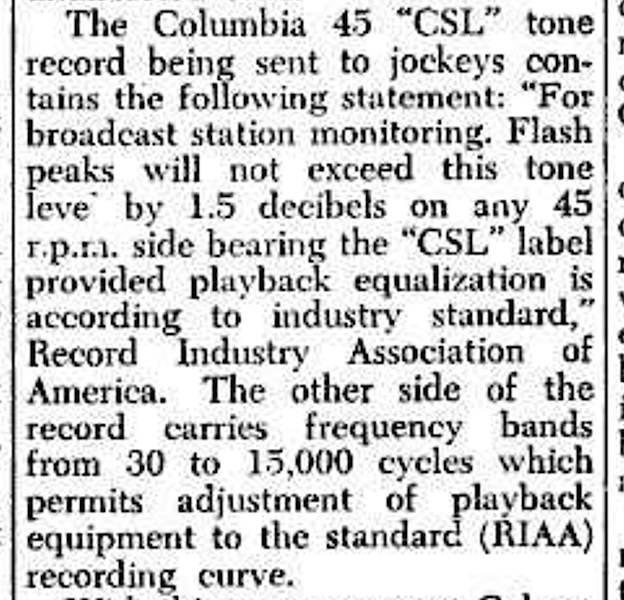
source: “Columbia Introduces Standard Recording Level on All 45’s”, The Billboard, Feb. 12, 1955, p.30
ラジオ局DJにテストレコードが提供されたことを伝える箇所
英 Record Collector 誌のサイトに「The Fight to Sound Right」(2013) という記事が掲載されています。Sundazed や Speakers Corner などの再発レーベルが、オリジナルLPの音を尊重してリイシューするのか、マスターテープの音を尊重してリイシューするのか、録音当時の音はどのようにテープに記録されていたのか、など、興味深い議論が行われているのですが、この中に CSL の話が出てきます。
Record Collector magazine (UK) has a web article, “The Fight to Sound Right” (2013), which discusses whether reissue labels such as Sundazed and Speakers Cornerreissue with respect the sound of the original LPs or the sound of the master tapes, and how the sound was recorded on tape at the time of the recording. In this context, CSL is mentioned as shown below:
Compression can be a tool for good and, as we see in today’s “level wars”, for bad. Back in the 60s compression was also sometimes used incorrectly. Many of Columbia’s early mono singles, for example, are notably “in your face”. “That was because there was a system in place called Columbia Standard Level,” says Irwin. “When they were creating a 45 for radio it had to be cut at a certain level regardless of whether it interfered with the sonic attributes. On the masters, you would see the letters ‘CSL’ after the track name. It was an indication that these are the tracks that you should cut the 45 from because they have been produced for singles.”
コンプレッションは良い結果をもたらすツールとして使える一方、昨今の「音圧競争」でみられるように悪い方向でも使えるツールでもある。1960年代には、コンプレッションは時に間違った使われ方をしていた。例えば、Columbia の初期のモノーラル・シングル盤の多くは、あまりにもあからさまだった。「Columbia Standard Level (CSL) というシステムがあったからだ」と(Sundazed CEO)ボブ・アーウィン氏は言う。「ラジオ局向けに45回転盤を制作する際、音質を損なうことになろうがお構いなしに、(CSL という社内ルールに基づき)一定のレベルでカットしなければならなかった。マスターには、トラック名の後ろに「CSL」と書かれている。つまり、これはシングル盤用に制作されたトラック(が収録されたテープ)だから、45回転盤をカットせよ、という指示だった。
“The Fight To Sound Right”, by Paul Rigby, Record Collector, February 24, 2013.CSL はあまりにも露骨なコンプレッション、かつシングル盤向けの低域増幅と高域減衰でしたが、Columbia に限らず、特に1960年当時のシングル盤、さらにはLPでも、同様にイコライザやコンプレッサ、リミッタを駆使してマスターテープに録音したり、マスターテープからカッティング用マスターテープを制作する際に同様の音作りをするケースが(特にポピュラー音楽で)多くありました。
CSL was too blatant in its compression, low-boost and high-attenuation for single records, but in many cases, especially in the 1960s, not only Columbia but many labels often did sound-making with equalizers, compressors, limiters, etc. to prepare cutting master tapes for 45 rpms (and even for popular LPs).
特によく売れた45回転盤などは、Columbia 社内のマスタリングスタジオ以外でもカッティングされることがあったはずです。そのため、Columbia 社外のマスタリングスタジオにも、Columbia 社内の技術スタンダードを浸透させるために、このようなテスト盤を作って周知徹底しようとした、という側面もあったのかもしれません。
Especially for best-selling 45 rpms, there must have been times when some of these records were cut at mastering studios other than Columbia’s. Therefore, it is possible that Columbia made this kind of CSL test records in order to spread its internal technical standards to mastering studios outside of Columbia, and to make sure that everyone in the business knew about them.
A面のレーベルには「… provided playback equalization is according to industry standard (R.I.A.A.)」(業界標準の RIAA EQ で再生してテストトーンを再生し)とあります。
Side-A label reads “… provided playback equalization is according to industry standard (R.I.A.A.)”.
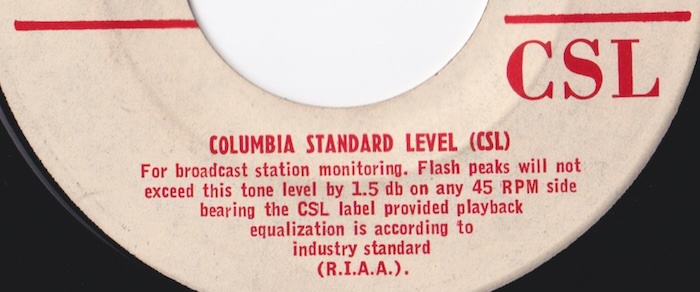
SIDE I, ZRD 429-1A (from my own collection)
COLUMBIA STANDARD LEVEL (CSL)
For broadcast station monitoring. Flash peaks will not exceed this tone level by 1.5 db on any 45 RPM side bearing the CSL label provided playback equalization is according to industry standard (R.I.A.A.)
B面にはさまざまな周波数のテストトーンが収録されているのですが、レーベルには「Columbia Standard Characteristic: as per R.I.A.A – N.A.R.T.B. industry norm」(コロムビア標準特性:RIAA および NARTB 業界標準の通り)という記載があります。
Side-B contains various frequency test tones, with the label which reads: “Columbia Standard Characteristic: as per R.I.A.A – N.A.R.T.B. industry norm”.

SIDE II, ZRD 431-1A (from my own collection)
COLUMBIA STANDARD CHARACTERISTIC as per R.I.A.A. — N.A.R.T.B. industry norm.
A playback system equalized to this standard should reproduce this record ± 1 db from 10 KC to 30 cycles, and from 15 KC to 10 KC ± 1 db at 6 db below that from 10 KC to 30 cycles.
つまり、Columbia が使用する標準特性は RIAAカーブであり、再生は RIAA カーブで行うように、さらに45回転盤はこの CSL に従って録音レベルを揃えてカッティングされていますよ(だから Columbia 45回転盤の再生時には RIAA 再生特性を使い、そしてフェーダのレベルを揃えてね)、と、ラジオ局に周知するためのテスト盤ということです。
So, in conclusion, this is a test disc to inform radio stations that (1) Columbia uses the RIAA curve as its standard characteristics; (2) the playback should be done with the RIAA curve; and (3) the discs are cut according to the CSL with recording level aligned. Columbia used this promotional disc to inform that it should be played back with RIAA curve and appropriate fader level (to match the CSL).
繰り返しになりますが、Columbia を含めた米メジャー5レーベルは、RIAA 規格を策定した技術委員会のメンバでもあり、業界を主導して RIAA 規格の普及に尽力していました。この盤が作られた主目的は CSL の周知でしたが、同時に RIAA 特性の普及の取り組みの一環でもあったのでしょう。
To reiterate, the five major U.S. labels (including Columbia) were members of the RIAA Engineering Committee, that developed the RIAA Standards. They led the industry in promoting the RIAA Standard. The main purpose of these “CSL” discs was to make the CSL known to the radio stations and public, but it was also part of the effort to promote the RIAA characteristics.
また、RCA Victor や Columbia のような巨大レーベルでは、米国内に多くのマスタリング拠点、プレス拠点を持ってため、社内での技術標準が独自で策定され、可能な限り均一な品質を確保していました。そのため、現場エンジニアの気まぐれや思いつきでその技術基準を逸脱することはできませんでした。
In addition, mega labels such as RCA Victor and Columbia had many mastering and pressing facilities in the U.S., so they established their own in-house technical standards (and engineering practices) to ensure uniform quality as much as possible. Therefore, it was impossible to deviate from these technical standards on the whims and fancies of the on-site engineers.
ましてや、Pt.19 セクション 19.3 でみたように録音特性(EQカーブ)の変更には録音機器への大掛かりな改造(や設定切り替えのたびの計測・較正)が必要で、そのたびに生産ラインをとめてしまうことになりますよね。
Furthermore, as we saw in Pt. 19 Section 19.3, changing the recording characteristics (EQ curve) would require extensive modifications to the equipment (as well as the measurements and calibrations each time settings were switched), and would stop the production line.
20.1.7 “How Quality Of Old Discs Is Brought Up In Standard” (Down Beat, Oct. 19, 1955)
Down Beat 1955年10月19日号 p.20 に掲載された寄稿記事「How Quality Of Old Discs Is Brought Up In Standard」(旧録音の品質はどのように標準レベルに引き上げられるか)では、16インチ33 1/3回転盤や78回転盤など、旧音源をリマスタリングし LP 化する際のプロセスを、あの Rudy Van Gelder 氏が解説しています。
In the contributed article “How Quality Of Old Discs Is Brought Up In Standard” on Down Beat, October 19, 1955, p.20, Rudy Van Gelder explains the process of remastering old recordings such as 16″ 33 1/3 rpms and 78 rpms for LPs.
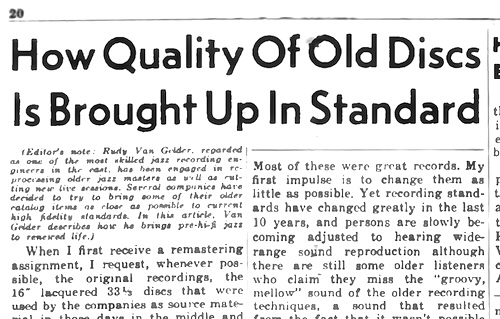
source: Down Beat, Oct. 19, 1955, p.20.
16インチ 33 1/3回転マスターや、78回転盤のメタルマザーをソースとして、フィルタリングやイコライジングを施しながらテープに記録する際、「音質と音楽性の間での妥協」が必要となるが、Van Gelder 氏はつねに「音楽性を重視した妥協」を選んでいる、と話しています。
Mr. Van Gelder says that “a series of compromises are necessary in the remastering process if you want to be faithful both to the sound and the music” when remastering from the old 16-inch 33 1/3 rpm masters and 78 rpm metal masters to the tapes using filters and equalizers. And he claims “I compromise always in favor of music”.
そして問題の部分。原盤の音源をリマスタリングしてテープに記録し終わったら、それを LP 用にカッティングするのですが、その作業に関して Van Gelder 氏が語る内容を引用します。
And the part in question — after the original recordings are remastered and recorded on tape, lacquers are cut for LPs, and here is what Mr. Van Gelder says about the process:
So, considering all these factors, I copy the disc onto tape. Then the tapes are edited in exactly the same way as the tape of a new date would be. After the editing, I cut a new master from the tape, and it is processed as a new release would be.
よって、これらの要素を考慮して、私はディスク原盤の音源をテープにコピーする。そして、新録のテープと全くおなじようにそのテープを編集する。編集が終わると、そのテープからマスターディスクをカッティングし、新譜と同じように処理される。
Incidentally, these remastered recordings should be played back with the same reproduction curve as any new records. In my case, I use the standard RIAA curve.
ちなみに、これらのリマスター盤は、新譜と同じ再生カーブで再生される必要がある。私の場合、標準規格である RIAA カーブを使っている。
“How Quality Of Old Discs Is Brought Up In Standard”, Down Beat, October 19, 1955, p.20.本稿 Pt.19 でみたように、Van Gelder 氏は 1955年から Gotham PFB-150WA パワーアンプ(RIAA 録音特性)を、1950年代末から Fairchild 641(RIAA 録音特性)を、最終的に 1965年から 3DII カッターヘッドを含む Westrex システム(RIAA 録音特性)を使っていたことが知られており、このインタビューの内容と矛盾しませんね。
As discussed in Pt.19, Mr. Van Gelder is known to have used Gotham PFB-150WA power amplifier (RIAA EQ inside) sinde 1955, Fairchild 641 system (RIAA EQ inside) sinde the late 1950s. And finally, Westrex system including 3DII cutterheads (RIAA EQ inside) have been in use since 1965. Therefore, this is consistent with the content of the Down Beat interview.
この「標準のRIAAカーブを使っている」が、再生規格を表す、という解釈も成り立ちますが、その場合も、いかなる録音カーブでカッティングしていようとも、Van Gelder 氏は RIAA カーブでの再生を前提としてリマスタリング(音作り)、そしてカッティングを行ったことになりますね。
One interpretation is that “I use the standard RIAA curve” indicates a playback curve, but even in that case, too, Van Gelder’s remastering (sound-making) and cutting was based on the assumption that the RIAA curve would be used during the reproduction, no matter what recording curve was actually used.
20.1.8 “Certified Record Revue” by Bert Whyte (Radio & Television News, from Sep. 1953 to Jan. 1960)
1950年代当時の(少し毛並みの違う)推奨再生カーブ情報を提示した興味深い例として、Radio & Television News のレコードレビューコーナー「Certified Record Revue」があります。1953年9月号にスタートしたコーナーで、1959年5月号から誌名が Electronics World と変更されても続き、1961年1月号が最後の掲載となりました。7年半以上に渡る長期連載コーナだったわけです。
An interesting example of the (slightly different) way to show recommended playback curve information from the 1950s is, “Certified Record Revue” section that had been published serially in the Radio & Television News. The section started in Sep. 1953 issue, and it continued after the magazine’s name was changed to “Electronics World”, until the Jan. 1961 issue. So it was the serialization over seven years.
評価者は、当時 MGM-Loew 社のマルチチャンネル(Perspectasound)部門に所属していた Bert Whyte 氏です。C.R. Fine 氏とも懇意でした。また、のちに Harry D. Belock 氏と共に、あの Everest レーベルを立ち上げることになります。RCA Victor Red Seal では音楽ディレクタを、Crystal Clear レーベルではスーパヴァイザを、それぞれ務めました。また、Audio 誌(元 Audio Engineering 誌)の副編集長も勤めたほか、1977年には AES フェロー となっています。(JAES 1994年6月号に掲載された追悼記事)
The reviewer is Mr. Bert Whyte, who was working at Perspectasound division of MGM-Loew. He was also a good friend of Mr. C.R. Fine. Also, he later would establish Everest label along with Harry D. Belock. He also worked as a musical director at RCA Victor Red Seal, supervisor at Crystal Clear label, respectively. He also was an associate editor of Audio magazine, and was given an AES fellowship in 1977. (see: obituary article published in the June 1994 issue of the Journal of the AES.)
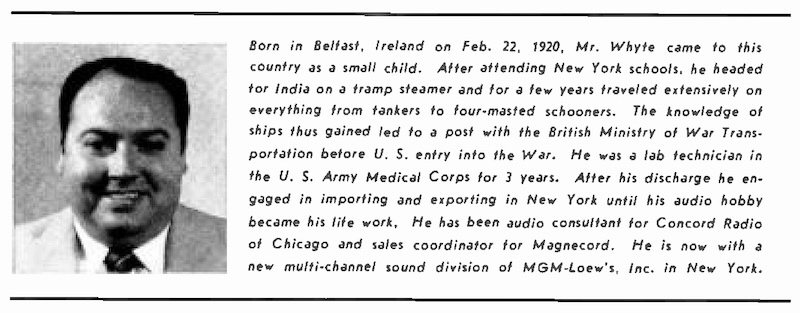
source: “Certified Record Revue”, Radio & Television News, November 1953, p.70.
これは、ごく一部の例外を除いてほとんどがクラシックLPのみが対象ですが、その演奏内容や音質をレビューし、同時にその評価者自身の考える推奨再生カーブとトーンコントロールの度合いを掲載している、というものです。
This “Certified Record Revue” reviews the performance and sound quality of classical LPs only (a few Pop/Jazz LPs were reviewed), and at the same time provides the evaluator’s own recommended playback curves and degree of tone controls.
つまり、レーベルごとの再生カーブ一覧表ではなく、レーベルごとの録音カーブ一覧表でもなく、個別のレコードについて慎重に試聴を行い、みずからが好ましいと判断した再生カーブを提示する、という、清々しく潔いスタイルです。
In other words, it is not a list of playback curves for each label, nor a list of recording curves for each label, but rather a clean and uncluttered style of presenting the playback curves that the reviewer has determined to be desirable after careful listening to individual albums.
1956年12月号までは、使用する再生機器群を明らかにした上でのレビューであることも特徴的です。一例として、1954年8月号の Certified Record Revue では、「ElectroSonic カートリッジ」「Pickering 190B トーンアーム」「Rek-O-Kut T 12H ターンテーブル」「McIntosh C-108 プリアンプ」「McIntosh 30W パワーアンプ」「Jensen 同軸3ウェイユニットを Jensen バックロードホーンに装着したもの」で試聴した、と書かれています。同じEQカーブポジション名であっても、プリアンプごとに異なる特性だった場合も多かったようですので、この記載は実直なものです。
The review is also unique in that it identifies the group of playback equipment used, until the Dec. 1956 issue. As an example, in the August 1954 issue of Certified Record Revue, the equipment used includes: “ElectroSonic pick-up”, “Pickering 190B arm”, “Rek-O-Kut T 12H turntable”, “McIntosh C 108 audio compensator”, “McIntosh 30-watt amplifier”, and “Jensen Triaxial in Jensen folded horn”. This is an honest description, as in many cases the same EQ curve position name would have had different characteristics for each pre-amplifier.
その上で、各種試聴レコード(ほぼすべてクラシック盤)の内容紹介が行われ、最後に Whyte 氏本人の判断による推奨再生カーブの説明とトーンコントロールの度合いが簡潔に添えられる、というスタイルのレビューとなっています。
The review is then followed by an introduction of the each disc (almost all classical recording), and finally a brief explanation of the recommended playback curve and degree of tone control as determined by Mr. Whyte himself.

source: “Certified Record Revue”, Radio & Television News, October 1954, p.60
「当コラムの意見は評価者(Whyte氏)の意見であり、本誌や本誌編集者の意見と必ずしも一致するとは限らない」と、わざわざ断り書きがあるのが面白い(笑)
レビュー内に「RIAA」という推奨ポジションが初登場するのは、1954年7月号、セクション20.1.4 で触れた、あの「The Curve That Conforms」が掲載された号です。
THe first appearance of the recommended position “RIAA” in the review was in the July 1954 issue, in which that “The Curve That Conforms” appeared, as already mentioned in Section 20.1.4.
それまでは「AES」や「NARTB (= 1949 NAB)」とされていた Capitol や、「ffrr」や「NARTB (= 1949 NAB)」とされていた London が、この号以降から「RIAA」とされるようになっています。もちろん、この号に掲載された盤から急に RIAA 特性での記録に変わったのではなく、レビューアの Whyte 氏にとって、より適切な再生カーブと判断できる RIAA ポジションが選択肢に追加された、ということなのでしょう。
Capitol, which was considered as “AES” or “NARTB (= 1949 NAB)”, and London, which was considered as “ffrr” or “NARTB (= 1949 NAB)”, are now considered as “RIAA” from this issue onward. Of course, this does not mean that the recordings suddenly changed to RIAA characteristics from this issue. Instead, it may be that the RIAA position was added as a new option, which was judged to be a more appropriate reproduction curve for Mr. Whyte, the reviewer.
同時に、同号に掲載された「The Curve That Conforms」の情報により、Capitol や London がすでに New Orthophonic = RIAA カーブを使っていることが判明したことにより、最初の試聴時に RIAA から試すようになったから、というのもあるでしょう。
At the same time, the information in “The Curve That Conforms” in the same issue revealed that Capitol and London were already using the New Orthophonic = RIAA curve, and this may be the reason why Mr. Whyte started trying the RIAA curve at the first listening.
例えば1954年8月号では、London LL.917 (Eduard van Beinum: Concertgebouw Orchestra of Amsterdam) では「トーンコントロールに頼ることなく RIAA カーブで良好な結果」、Mercury MG-50028 (Paul Paray: Detroit Symphony Orchestra) では「微調整なしで RIAA カーブが適切であった」、Columbia ML-4859 (Robert Whitney: Louisville Orchestra) では「NARTB (= 1949 NAB) カーブ、ただし、トーンコントロールで高域を若干カットし、低域を少し持ち上げる必要あり」、Capitol P-8257 (Vladimir Golschmann: St. Louis Symphony Orchestra) では「ほんの少し低域を持ち上げれば RIAA カーブで良好な音」、といった感じで解説されています。
For example in the Aug. 1954 issue, for London LL.917 (Eduard van Beinum: Concertgebouw Orchestra of Amsterdam), he writes “The RIAA curve was OK without recourse to bass and treble controls”; for Mercury MG-50028 (Paul Paray: Detroit Symphony Orchestra) “RIAA curve was adequate without adjustment”; for Columbia ML-4859 (Robert Whitney: Louisville Orchestra), “NARTB curve needed a little treble cut, slight bass boost”; and Capitol P-8257 (Vladimir Golschmann: St. Louis Symphony Orchestra), “The RIAA curve sounded OK with a smidgin’ of bass boost”. He consistently describes equalization info like these.
面白いのが Epic LC-3008 (Paul van Kempen: Concertgebouw Orchestra of Amsterdam) で、推奨カーブは暫定的に NARTB (= 1949 NAB) とされていますが、「演奏内容は素晴らしい。しかしこの音はなんだ! バランスのとれた音にするべく、EQ スイッチをグルグル回して操作し続け、腕と耳が疲れてしまった。低域が信じられないほどブーミーで、高域はここ数年で最もキンキンしている。トーンコントロールで高域を完全にオフにしても、まだストリングスの音がエッジーである。最悪なのはホールの残響時間が長すぎ、全ての音がいっしょくたになり、質感が失われていることだ。演奏自体は素晴らしいのに本当に残念である。(中略)上述の通り、いかなるEQカーブの設定も無意味だろう」と音質面で酷評されています。
“But the sound! I dial twiddled and threw equalization switches trying to balance this sound, until my arms and ears got tired. Bass is incredibly boomy and mushy, treble the most strident I have run across in ages. Even when I turn the treble completely off, the edge was still in the strings. One of the worst faults was excessive reverb time in the hall, making all the sound and fury of the bells in the finale “run together” and lose texture. Too bad, because the performance is outstanding. (…snip…) As you can understand from the foregoing, any attempt on my part to describe equalization would be pointless.”
このように、Whyte 氏の推奨する再生カーブが記されたレコード評のスタイルですが、2年後の 1955年11月号 でレビューされた Columbia ML-4992 で「この盤はRIAAカーブで再生のはずだが、私には旧NARTBの方が好ましい再生に聞こえた」と書かれたのを最後に、それ以降は全てのレビュー対象盤が「RIAA Curve」と記載され続けます。
The style of Mr. Whyte’s record review is such that his recommended playback curve is noted, but two years later in the November 1955 issue, Columbia ML-4992 was noted as “This disc is supposed to be reproduced with the RIAA curve, but I found the old NARTB more suitable to my ear”, and this was the last title of him recommending non-RIAA playback curve. From then on, all the reviewed discs were listed as “RIAA Curve”.
この頃になると、各盤のレビュー文の中には再生カーブやトーンコントロール調整の話すら出てこなくなりますが、引き続きレーベル名、カタログ番号、タイトル、価格などと共に「RIAA Curve」と律儀に表記し続けられます。また、1956年12月号を最後に、レビューで使った試聴システムも明示されなくなりました。
By this time, the review text for each disc no longer even mentions the playback curve or tone control adjustment, but continues to dutifully refer to the “RIAA Curve” along with the label name, catalog number, title and price. Also, after the December 1956 issue, the listening system used in the review is no longer explicitly mentioned.
そして、1958年3月号 では、ついに「特記なしは全てRIAA再生カーブ」と明記され、各盤のレビューでは推奨再生カーブが省略されました。その後の号でも「特記」は一切登場しませんでした。
Finally, in the March 1958 issue, it was clearly stated that “unless otherwise indicated all discs reviewed are 12-inch 33⅓ rpm long play with RIAA playback equalization.”, and the recommended playback curves were ommited from the reviews of each disc. No “special indication” appeared in subsequent issues.

source: “Certified Record Revue”, Radio & Television News, March 1958, p.92.
ついに盤ごとの推奨再生カーブ表記がなくなった号に書かれた「特記なきはRIAAカーブである」という文言。
なお、1958年4月号 からは、ステレオ盤のレビューも始まりました。当然ながら特記なしで、モノ・ステレオ問わず RIAA 再生カーブ前提でのレビューです。
In the April 1958 issue, he started reviewing stereophonic records. Naturally, all the reviews are based on the assumption of RIAA playback curves both for mono and stereo records.
このように、Whyte 氏の連載レビューにおいては、1953年9月号〜1955年11月号には非RIAAカーブでの再生を推奨する盤が登場するが、1955年12月号以降は全てRIAAカーブでの再生推奨、となっています。
Consequently, in Mr. Whyte’s serialized reviews, the Sep. 1953 – Nov. 1955 issue had discs recommended for playback with non-RIAA curve, but from the Dec. 1955 issue onward, all reviewed discs were recommended for playback with the RIAA curve.
もちろん、Bert Whyte 氏の「推奨再生カーブ」が、確かに信頼できる一次情報だ、と言いたいのではありません。
Of course, I do not mean to imply that Mr. Bert Whyte’s “recommended playback curve” is indeed reliable primary information.
当時のオーディオマニアの方々が、特にRIAA規格登場後1年くらいまでの、混乱している録音再生カーブ事情の中、どのようにして「少しでもレーベルの意図した音、または、良く聴こえる音で、それぞれの盤を再生する」ことと格闘していたのか、その典型例をみることができる、という点が重要だと考えます。
Instead, it is important to note that we can see a typical example of how audiophiles at that time, especially in the confusing recording / reproducing curve situation until about a year after the RIAA Standard, struggled to “play back each disc with the sound that the label intended, or that sounded good.”
そして、そんな Whyte 氏が、RIAA 策定前の 1953年9月号から始め、RIAA 再生カーブに準じた盤が増えていく時期も捉え、ステレオ盤レビュー初登場の1958年4月号以後も続けられ、1961年1月号まで続いた、この7年半近く続けられたレビューコーナーは、まさにEQカーブの標準規格化とその浸透の歴史・系譜をある側面から捉えた、貴重な記録資料と言えると思うのです。
Mr. Whyte started this review section in Sep. 1953, before the RIAA Standard was established. He continued the reviews for nearly seven and a half years, capturing the period when the number of recordings conforming to the RIAA curve increased. And he continued it after the April 1958 issue, when the first stereophonic record review appeared, until the January 1961 issue. I think it is a valuable document that captures the history and genealogy of the standardization of the EQ curve and its penetration from a certain aspect.
もし興味のある方がいらっしゃったら、Radio News (1953年9月号〜1959年4月号)、および Electronics World(1959年5月号〜1961年1月号)の Whyte 氏のレビュー記事をじっくり楽しんでみてください。独特の筆致で紡がれるレビュー内容は好き嫌いが分かれるかもしれませんが。
If anyone is interested, please take time to enjoy Mr. Whyte’s review articles in Radio News (Sep. 1953 to Apr. 1959) and in Electronics World (May 1959 to Jan. 1961), although his reviews are unique, and may not be for everyone.
20.1.8 Listening in Depth: An Introduction to Columbia Stereophonic Sound
1958年秋頃にリリースされたと思われる、“Listening in Depth: An Introduction to Columbia Stereophonic Sound” (Columbia SF-1) という LP ボックスがあります。このアルバムは、High Fidelity 誌1958年10月号のレビューに、London PS-100 “A Journey into Stereo Sound” と共にレビューされています。
There is an LP box entitled “Listening in Depth: An Introduction to Columbia Stereophonic Sound” (Columbia SF-1), presumably released in the fall of 1958, because this album was reviewed (along with London PS-100 “A Journey into Stereo Sound”) by Edward Tatnall Canby, in the October 1958 issue of High Fidelity magazine.
(from my own collection)
(from my own collection)
ステレオLPが市場に大々的に投入される前、VL方式と45-45方式のどちらを業界標準にするか、1957年11月7日〜 に EIA (Electronic Industries Association) および RIAA (Record Industry Association of America) 技術委員会で議論された結果、1958年3月27日、最終的に 45-45 方式が業界標準として採用されました。
Before stereophonic LPs were introduced to the market on a large scale, the EIA (Electronic Industries Association) and RIAA (Record Industry Association of America)’s Engineering Committee had discussed whether the VL system or the 45-45 system should be the industry standard since November 7, 1957. Then, the 45-45 system was finally adopted as the industry standard on March 27, 1958.
この 45-45方式に収まるまでの経緯は、H.E. Roys 氏が Journal of AES 1977年10/11月号(Vol.25, No.10/11)に掲載した論文「The Coming of Stereo」で詳しく解説されています。
The process of settling on this 45-45 system is described in detail, in the article “The Coming of Stereo” by H.E. Roys, in the Oct/Nov 1977 issue of the Journal of the AES (Vol.25, No.10/11).
その後、1958年5月頃から、各レーベルが一斉に(すでにオープンリールで出していたステレオ音源を中心に)ステレオLPのリリースを開始しました。
And around May 1958, labels began simultaneously releasing stereo LPs (contents mainly stereo recordings that had already been released on reel-to-reel tapes).
ほとんどのレーベルは、1958年3月27日の 45-45 方式標準化を待ってからステレオLPをリリースしましたが、Audio Fidelity レーベルが “Compatible Stereophonic Demonstration Record” (Audio Fidelity AFLP-1872) を先行してリリースしていました。1957年11月のことでした。
Most labels waited until the March 27, 1958 standardization of the 45-45 system before releasing stereophonic LPs. However, the Audio Fidelity label preceded them with the release of “Compatible Stereophonic Demonstration Record” (Audio Fidelity AFLP-1872) in November 1957.
500枚しか製造されなかったそうで、1957年12月13日にニューヨークのタイムズ・オーディトリアムで再生デモが行われたほか、Billboard 1957年12月16日号の記事「Mass Produced Stereo Disk Is Demonstrated」でも取り上げられたほか、同号には Audio Fidelity ステレオ LP の一面広告 も掲載されました。
Only 500 copies were made, and a playback demonstration was held at the Times Auditorium in NYC on December 13, 1957. It was featured in the Dec. 16, 1957 issue of The Billboard in the article “Mass Produced Stereo Disk Is Demonstrated”. The same issue also included a full-page ad for Audio Fidelity’s STEREODISC.
In the words of Sid Frey, Audio Fidelity topper, the disk is a “hi-fi curiosity” rather than a product for mass use. Widespread sale and use of disk is, of course, impossible because the equipment on which it is played is not available. Frey is making the disk available to interested people in the record industry at no charge. He believes it will help engineers test prototypes of stereo cartridges.
Audio Fidelity 社のトップ、Sid Frey 氏の言葉を借りると、このレコードは大衆向けの製品ではなく、「ハイファイ用珍品」なのである。このレコードを再生する機器が入手不可能であるため、広く販売し再生してもらうことはできない。Frey 氏は、この盤をレコード業界の関係者に無料で配布している。エンジニアがステレオカートリッジのプロトタイプをテストするのに役立つだろう、と Frey 氏は考えている。
“Mass Produced Stereo Disk Is Demonstrated”, The Billboard, Dec. 16, 1957, p.27その他、Bel Canto などいくつかのマイナーレーベルもステレオサンプラー盤をリリースしたそうですが、この Audio Fidelity AFLP-1872 が「世界初の量産 45-45 ステレオ盤」ということになるようです。
Some other minor labels such as Bel Canto also released stereo sampler discs without waiting for the 45-45 system to be adopted in the industry, but it seems that this Audio Fidelity AFLP-1872 is the “world’s first mass-produced 45-45 stereo disc”.
45-45 方式標準化後、各レーベルによってステレオ盤やサンプラー盤のリリースが徐々に始まりましたが、1958年秋頃リリースと思われるこの Columbia SF-1 もそんな1枚です。
After the standardization of the 45-45 system, each label gradually started releasing stereophonic LPs and stereophonic sampler albums. This Columbia SF-1, arguably released in the fall of 1958, is one of them.
(近いうちに、機会を改めて、1957年11月〜1958年のステレオLPリリース状況を、当時の資料から追ってみることにします)
(In the near future, I will take another opportunity to trace the status of stereo LP releases from November 1957 to 1958, by tracing the documents available at that time)
この LP の非常に興味深い点は2つあります。ひとつは、45-45 ステレオ LP 再生時に、レコードの溝が再生針をどのように動かしているか(再生針がレコードの溝をどのようにトレースするか)を視覚的に表現するために、パラパラマンガ が付属していることです(笑)
There are two very interesting aspects of this particular LP box. One is that it comes with a flip-book to visually represent how the stereophonic groove moves the needle (i.e. how the stylus traces the stereophonic groove) when playing a 45-45 stereo LP.
1958年暮れリリースの Listening in Depth: An Introduction to Columbia Strreophonic Sound (Columbia SF-1)
— Kohji Matsubayashi (@kohji405mi16) May 10, 2023
ステレオ盤で針がどうトレースするか図解したパラパラ漫画ブックレットが付属。楽しい。
御大 William S. Bachman 氏自ら RIAA 録音カーブとカートリッジの技術仕様を解説。 https://t.co/6dfL626BCY pic.twitter.com/CYgj8nQnEc
もうひとつは、付属ブックレットに、Columbia のチーフエンジニアである William S. Bachman 氏の技術解説 が掲載されていることです。当たり前ですが、RIAA 特性でカッティングされたこの盤にあわせて、RIAA 録音特性の解説が行われ、また当時まだ一般リスナーにとって主流だった圧電式(クリスタル、セラミック)カートリッジでフラット再生するための補正回路の解説も行われています。
The other is that the accompany booklet includes a technical explanation written by William S. Bachman, Columbia’s chief engineer. It explains the RIAA recording characteristic for this disc, which was (of course) cut with RIAA curve, as well as the compensation circuit for flat reproduction with piezoelectric (crystal and ceramic) cartridges, which were still the mainstream for ordinary listeners at the time.
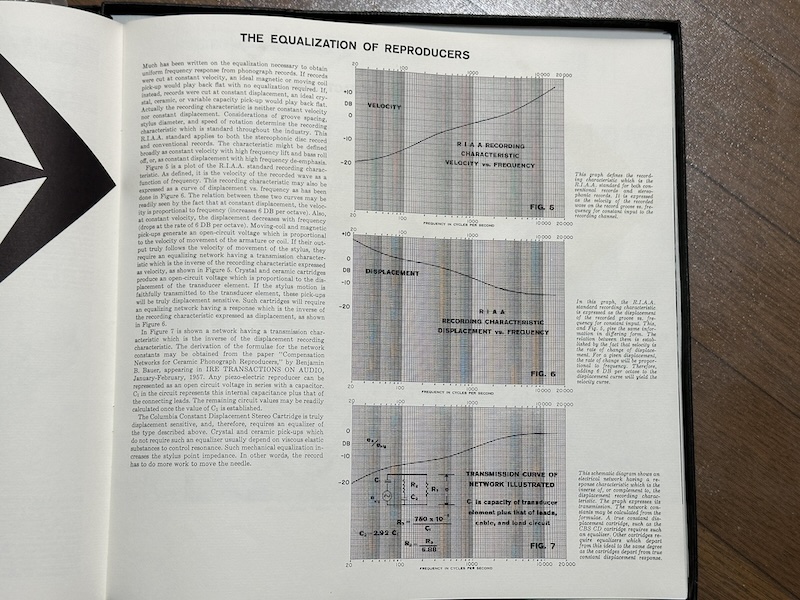
source: booklet from Columbia SF-1 (from my own collection)
RIAA 録音特性、および圧電式カートリッジでフラット再生するための補正回路、に関する、御大 Bachman 氏自らの解説。
RIAA 録音再生規格を策定したメンバの1人である Columbia チーフエンジニア William S. Bachman 氏により、ステレオ盤および通常盤(モノーラル)で RIAA 規格が業界全体で使われていることが解説されています。そしてこの文章からは、レコードに音を刻むという技術の歴史について、非技術者向けに可能な限り平易に解説されようとしていることが伝わってきます。
Mr. Bachman, who was one of the five members of the RIAA Engineering Committee (that formulated the RIAA Standards itself), explains the industry-wide use of the RIAA standard both for stereo and conventional (monaural) records. His text also conveys an attempt to explain the history of the art of engraving sound on disc in as simple a manner as possible for the non-technical people.
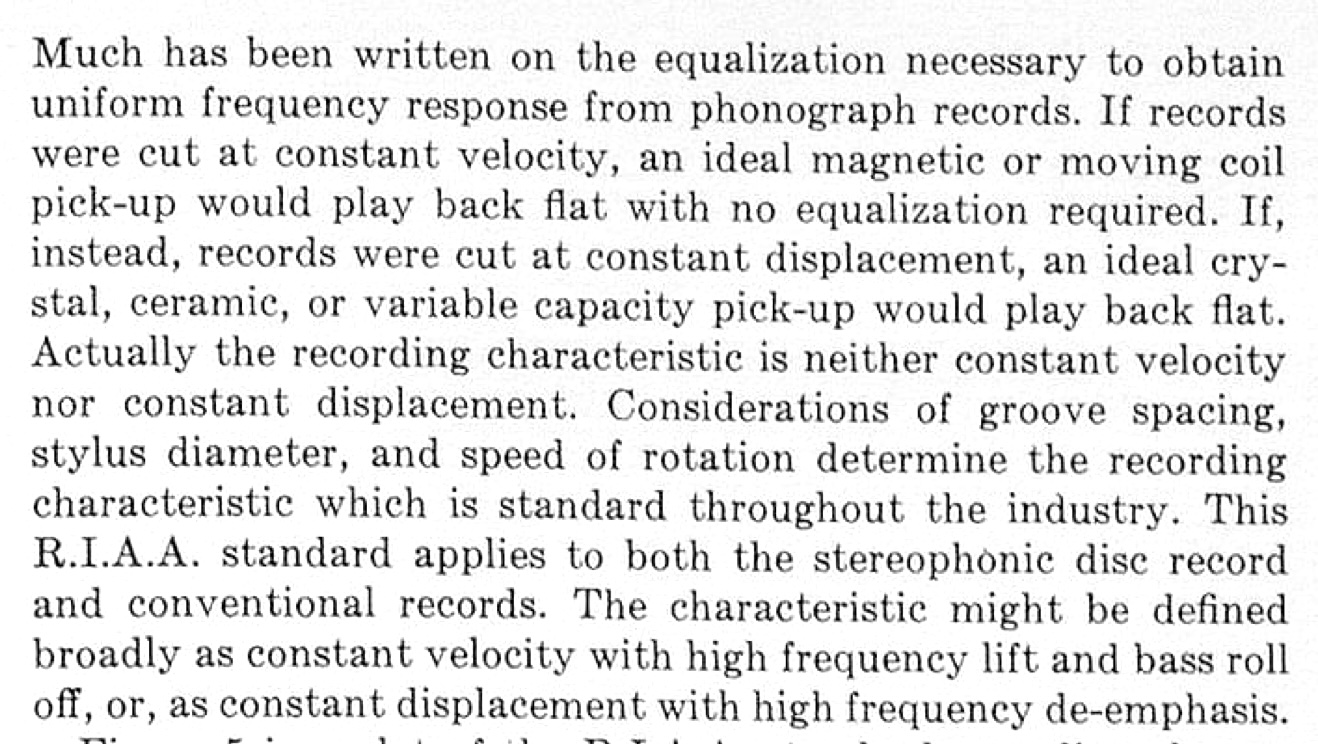
(from my own collection)
Bachman 氏による RIAA 標準規格の解説
Much has been written on the equalization necessary to obtain uniform frequency response from phonograph records.
レコードからフラットな周波数特性を得るために必要なイコライジングについては、過去に多くのことが書かれてきた。
If records were cut at constant velocity, the ideal magnetic or moving coil pick-up would play back flat with no equalization required.
もし、レコードが定速度記録でカッティングされていたならば、理想的なマグネットカートリッジやMC型カートリッジで再生すれば、イコライザなしでフラット再生が行われることになる。
If, instead, records were cut at constant displacement, an ideal crystal, ceramic, or variable capacity pick-up would play back flat.
逆に、定変位(定振幅)でレコードがカッティングされていたならば、理想的なクリスタルカートリッジ、セラミックカートリッジなど、可変容量カートリッジでフラット再生ができることになる。
Actually the recording characteristic is neither constant velocity nor constant displacement.
(しかし)実際には、(レコードの)録音特性は定速度でも定変位(定振幅)でもない。
Considerations of groove spacing, stylus diameter, and speed of rotation determine the recording characteristic which is standard throughout the industry.
溝の間隔、スタイラスの直径、回転速度などを考慮することで、業界全体で標準化された録音特性が決定される。
This R.I.A.A. standard applies to both the stereophonic disc record and conventional records.
この R.I.A.A. 標準規格は、ステレオ盤と、従来からの(モノーラル)盤の両方に適用されるものである。
The characteristic might be defined broadly as constant velocity with high frequency lift and bass roll off, or, as constant displacement with high frequency de-emphasis.
この特性は、ざっくりというと、高域リフトおよび低域のロールオフを伴う定速度特性、あるいは、高域のデエンファシスを伴う等変位(等振幅)、と定義できることになる。
“Equalization of Reproducers” by William S. Bachman (on Columbia SF-1's booklet)20.1.9 Few objective data survives and/or being public
残念なことに、当時の業界誌(The Billboard, Cash Box, その他)、オーディオ工学系の雑誌や論文誌(Audio Engineering 誌や AES 論文誌、その他)などをどんなに探しても、どのレーベルがいつ録音特性を変更したのかのヒントになる「確度の高い一次情報、または一次情報を元にしたと思われる情報」が、これ以上なかなか見つかりません。
Unfortunately enough, no matter how hard I search the trade magazines of the time (The Billboard, Cash Box, and many more) and audio engineering magazines and journals (Audio Engineering magazine, AES Journal, and many more), etc., it is difficult to find any more “objective” “primary” information, or “information that seems to be based on primary information”, that gives us a clue as to which labels changed recording characteristics to RIAA and when.
正確な情報を得るには、各レーベルやスタジオのエンジニアによるメモ、内部文書、それらをひもとくしかないのですが、残念ながら、そのほとんどが、現在の所有者(所有社)によって、研究目的であっても門外不出となっています。
The only way to obtain accurate information is to dig through the notes and internaldocuments of the engineers at each label and studio. Unfortunately, most of these documents are kept out of sight, even for research purposes, by the current owners (and owning companies).
例えば、存在が確認されている有名なものに、1955年頃の Columbia の内部文書があります。この連載記事にも何度も登場している、当時の Columbia チーフエンジニア William S. Bachman 氏が書き残したメモです。
For example, one well-known document that has been confirmed to exist is an internal Columbia technical document from around 1955. These are memos written by Mr. William S. Bachman, who Columbia’s chief engineer at the time (and who have appeared so many times in my series of blog articles).
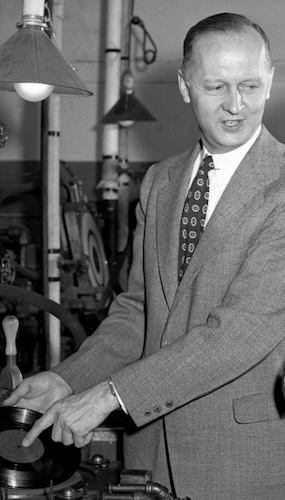
(from Discogs contributed image)
音楽評論家・オーディオ評論家として有名な Michael Fremer 氏が Analog Planet に掲載した2014年の記事「Phono Equalization B.S. Continues!」(フォノイコのくだらないデタラメはどこまでも続く)から引用します。この記事は「Capitol がステレオ時代に RIAA を使っていたことは Roy McMaster 氏に直接聞いて確認した」「London / UK Decca がステレオ時代に RIAA を使っていたことは、1957年〜1972年にマスタリングを担当していた George Bettyes 氏に直接確認した」など、ステレオ非RIAA説を痛烈に批判する内容で有名です。
Following is a quote from the 2014 article “Phono Equalization B.S. Continues!”, published in Analog Planet, written by Mr. Michael Fremer, a well-known music / audio critic. BTW this article is famous for its harsh criticism of the “non-RIAA for stereo records” opinion, such by “I ASKED Ron McMaster as he sat at the mastering board in Capitol’s mastering suite”, “I asked veteran Decca mastering engineer George Bettyes who mastered between 1957 and 1972”, etc.
As for the notion that the Columbia curve used in the early LP days for mono LP playback (and useful for those records today) somehow continued being used in the stereo era, this too is simply NOT TRUE. I received this from someone who was there:
初期LP時代にモノーラルLPの再生に使われていた(そして現在でもそれら古いレコードの再生に使われている)Columbia LP カーブが、どういうわけかステレオ時代にも使われ続けている、という説があるが、これまたシンプルに「真実ではない」。実際、現場にいたある人から次のようなメッセージを受け取った。
“When Sony closed 54th Street, we discovered a large amount of old Columbia documentation. Binders full of memos, schematics, etc… I’ve taken it upon myself to scan all of these documents for posterity. I came across one that answered the burning RIAA/Columbia curve question from a few months ago.”
「Sony が 54番街(のオフィス)を閉鎖した際、我々は古い Columbia の資料を大量に発見した。バインダーいっぱいのメモ、回路図など。私はそれらの書類を後世に残すため、全てスキャンすることにした。そしてその中に、数ヶ月前の RIAA / Columbia カーブに関する疑問の答えとなる文書を見つけた。」
“It was a document from William (Bill) Bachman, Director of Electronic Engineering and Research. He states some general facts about the Columbia curve and how the competition has tried to alter their curves to mimic the Columbia curve. This has forced a standard to arise, the RIAA curve, which is identical to the NARTB standard.”
「それは、電子工学・研究部門のディレクタだった William S. Bachman 氏の書いた文書だった。その文書で彼は、Columbia カーブに関する一般的事実と、競合他社が Columbia カーブを模倣してどのようにカーブを変更しようとしていたか、を記していた。このことにより、NARTB 規格と同一である RIAA カーブという標準規格を作ることになった。」
“He plots a graph to show the similarities and discusses the differences between the two. He goes on to state that the differences in production can account for a greater difference than the difference between the two curves.”
「彼はグラフを描いて(Columbia LP カーブと RIAA カーブの)類似点を示し、両者の違いについて論じている。彼はさらに、カーブの差分よりも、製造時の差分の方が大きな違いを生むと述べている。」
“And here’s the kicker…He says the RIAA curve is ideal for playback of Columbia LPs and that a gradual change over to RIAA should be carried out without distinguishing the differences between the RIAA and Columbia pressings.”
「そして、ここからが重要なのだが、Bachman 氏は、RIAA カーブは Columbia LP 再生に理想的であり、RIAA カーブの LP と Columbia LP カーブの LP の違いを区別することなく、徐々に RIAA に切り替えていくべき、と述べている。」
“This document is not dated, but it’s wedged in between a memo from 1955 and 1956.”
「この文書に日付は書かれていないが、1955年と1956年のメモの間にはさまっている。」
“I feel this is the document which clarifies that Columbia dropped their curve in the mid-50’s and quietly gravitated toward the RIAA curve and was not using the proprietary curve in the 70’s.”
「これは、Columbia が1950年代半ばに自社のカーブをやめ、徐々に RIAA カーブへと移行し、1970年代には独自カーブを使用していなかったことを明らかにする文書だと私は思う。」
“Phono Equalization B.S. Continues!”, Analog Planet, October 4, 2014.昨年から、米国の研究者やエンジニアの協力のもと、この文書のありかを探してきました。
Since last year, with the help of some U.S. researchers and engineers, I have been searching for the whereabouts of this document.
結果、この文書が現存し、現在も某所で保管されていることを確認できました。
As a result, I was able to confirm that this particular document exists, and that it is still being kept at a certain venue.
そして、その保管場所とは、今から14年前に私に初めてメールをくれ、その後ことあるごとにメールをやりとりさせていただいてきた、著名な某エンジニアが所属されている某スタジオであることも判明しました。
Furthermore, it turned out that “a certain venue” was the studio that a famous and acclaimed mastering engineer now belongs to. Also, the engineer is the man who first sent me an e-mail 14 years ago, and with whom I have been exchanging e-mails ever since.
その後、ダメ元で彼にメールを送ってみると、確かにここにある、と教えてくれました。
Then I thought it won’t hurt to ask him — and he emailed me back, “(the document) is right down the hall.”
しかし、「これらの書類は会社の所有物であり、順守しなければならない規則があるため、コピーを提供することはできない」という返事を彼からもらいました。ともあれ現存することはまちがいありません。
However, he also noted as follows: “I cannot provide copies of these documents because they are company property and there are rules I must follow”. At any rate, there is no doubt that it is still in existence.
この Columbia の内部技術資料のように、存在はするが、一般公開されていない(できない)文書やメモ、資料がたくさんあるのでしょう。そのため、我々市井の音楽愛好家は、限られた客観的情報や状況証拠から推論を行うしかないわけです。
There must be many other documents, memos and materials that exist but are not (or cannot be) made available to the public, such as this Columbia’s internal technical document. Therefore, we music lovers on the street can only make inferences based on limited objective information and circumstantial evidence.
そのため、複数の説が流布し、そのなかには珍説が含まれてしまったりするわけなのでしょう。
This is probably why several theories have been circulated, some of which are odd and/or absurd.
20.2 Learning the Various Sources of “EQ CURVES”
High Fidelity 誌の1953年1/2月号〜1957年10月号に掲載された、例の「Dialing Your Disks」(Pt.17 セクション 17.6 参照)や、当時の民生用プリアンプの取説などに端を発し、「この時期のレーベルは〇〇カーブである」という各種一覧表が、時代を経るごとに修正されたり統合されたりしながら、現在に至るまでさまざまなバリエーションとなって流通しています。
The “Dialing Your Disks” (see: Pt.17 Section 17.6), which appeared in the Jan./Feb. 1953 to Oct. 1957 issues of High Fidelity magazine, and the instruction manuals of consumer pre-emplifiers of the time, led to various lists of “label A’s curve from this period is B”. These lists and tables have been modified and consolidated over time, and many variations have been circulated to this day.
しかし、嚆矢のひとつであった「Dialing Your Disks」も、連載当初は「各レーベルに問い合わせをして、レーベルが回答した 推奨再生ポジション」の一覧(カッティング時の録音カーブではないことに注意)でしたが、連載が進むにつれ、次第に推測混じりの情報となり、またパラメータなどの信憑性もあやしくなっていました。
However, although the pioneering “Dialing Your Disks” was initially a list of “recommended playback curves by the labels themselves” (note that these were not the recording curves used when cutting), the information gradually became mixed with speculation and the reliability of the parameters became questionable as the series progressed.
つまり、これらの一覧表はすべて、「A という録音カーブを使用した、すなわち A カーブが正解である」ということを意味しているわけではありません。あくまで「ゆるやかな集合知による論理的整合性向上パズル」でしかありませんし、せいぜい「A という再生カーブで聴くことを推奨」の叩き台でしかないことに留意しなければなりません。
In other words, all of these lists do no imply that “a recording curve called A was used, i.e. curve A is the correct answer”. It should be noted that this is only a “endless puzzle for improving logical consistency through loose collective knowledge”, and at best it is only an eternal draft of “we recommend listening to the record using the playback curve called A”.
その上で、個々のリスナーが、個々のレコードに対して「A という再生カーブで聴くと気持ちよく聞こえる」といった主観的判断を行うしかないのです。なぜならば、実際の一次資料に基づいた客観的情報のみで構成されていないからですし、調査研究によって最新の解釈・候補がアップデートされていく類のものだからです。
Then, individual listeners can only make subjective judgements about each record, such as “it sounds good when listened to with a playback curve of A”. This is because it does not consist sorely of objective information based on actual primary sources, and the latest interpretations and candidates are updated through ongoing researches and studies.
20.2.1 Notable Resources (1): “Audiophile’s Guide to Phonorecord Playback Equalizer Settings” by James R. Powell, Jr.
古典的なEQカーブ一覧表として、James R. Powell, Jr. 氏が ARSC (Association for Recorded Sound Collections) の論文誌1989年春号に掲載した「Audiophile’s Guide to Phonorecord Playback Equalizer Settings」という文書があります。本稿で紹介する他の情報源も、これを参照したり出典としています。
A classic list of EQ curves was published by Mr. James R. Powell, Jr. in the Spring 1989 issue of the ARSC (Association for Recorded Sound Collections) Journal, entitled “Audiophile’s Guide to Phonorecord Playback Equalizer Settings”. Other sources of information presented in this Pt.20 article also refer to it or use it as one of the sources.
1989年当時に入手可能だったさまざまな資料(出典や参考資料も明記)を元に構成された一覧表で、RIAA 以前のレコード再生用、特に古い音源の “Archival”(アーカイブ用、記録保管・復刻用)に作られたカーブ可変フォノイコの先駆けである Owl Audio Products (Conductart) Owl 1 Restoration Module に基づいて、さまざまなレーベル用の推奨再生カーブを提示しているものです。現在に続く、RIAA 以前の盤のカーブ探究の先駆けにあたる貴重な資料です。
This list is organized based on various documents available at the time of 1989 (sources and references are also noted). It provides recommended playback curves for various labels based on the Owl Audio Products (Conductart) Owl 1 Restoration Module (a precursor to the “archival” variable phono equalizers created in later years) for pre-RIAA record playback.
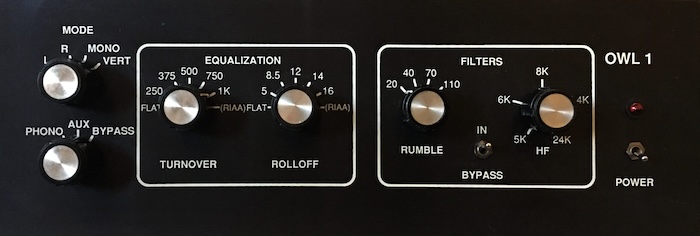
source: “Deep Groove Mono’s Great 78 Adventure”.
Owl 1 フォノイコのフロントパネル写真
独特のターンオーバー/ロールオフ値の他、右側のランブルフィルタ、ローパスフィルタが、いかにも78回転盤用フォノイコであることを主張しています

source: UK Audio Mart entry.
OWL 1 付属のマニュアル群。真ん中が取説で、左右はレーベルごとの推奨カーブ設定一覧と思われる。
この James R. Powell, Jr. 氏の文書の負の遺産としては、AES カーブのターンオーバ周波数 400Hz を 375Hz と記してしまったことが挙げられます。これは、Owl 1 フォノイコのターンオーバーの選択肢が「250 / 375 / 500 / 750 / 1K / (RIAA)」となっていたため、AES カーブの 400Hz に最も近い値として 375Hz のポジションが推奨され、その結果、カーブ一覧表に「AES (375)」と表記されてしまったことに由来しています。
One negative legacy of this Mr. James R. Powell, Jr.’s document is that it noted the AES curve’s turnover frequency of 400Hz as 375Hz. This was because the turnover choices for the Owl 1 phono preamp were “250 / 375 / 500 / 750 / 1K / (RIAA)”, and the 375Hz position was recommended as the closest value to the 400Hz of the AES curve, resulting in the list being labeled “AES (375)”.
Powell 氏のこの文書全体を読めば分かる通り、AES カーブの正しいターンオーバ周波数は、元論文の通り(Pt.16 セクション 16.4 参照)400Hz であることは間違いありませんし、Powell 氏はそれを承知の上で、「Owl 1 フォノイコ上でのポジションを示すために」、あえて「AES (375)」と表記していることが分かります。しかし、この表記のために、「AES カーブはターンオーバ 375Hz が正解である」という説が登場し、一部で混乱を招いたことも事実です。
As you can see from reading this entire document by Mr. Powell, the correct turnover frequency of the AES curve is definitely 400Hz, as stated in the original paper (see: Pt.16 Section 16.4). Mr. Powell knew this, and he dared to refer to it as “AES (375)”, to “indicate the position on the Owl 1 phono preamp”. However, it is also true that this notation has caused some confusion, as the opinion that the correct AES curve is turnover of 375Hz has appeared.

source: “Audiophile’s Guide to Phonorecord Playback Equalizer Settings”.
Powell 氏の文書の末尾「Definitions(定義)」で、AES の厳密なパラメータについて簡潔に書かれている箇所
では、Owl 1 で、なぜ「400」ではなく「375」という半端なポジションが用意されたのでしょうか。
So, why was the half-way position “375” prepared for the Owl 1 preamp, instead of “400”?
これはあくまで推測ですが、電気録音最初期向けの「250」というポジション(実はこれも「200Hz〜300Hz」の折衷案)と、戦後〜マイクログルーヴ時代に一般的となった「500」というポジション、両者の中間値をとった、つまり \((250 + 500) \div 2 = 375\) ということではないでしょうか。
This is just my guess, but it might be that the “375” position on Owl 1 was the middle value between the “250” position (actually a compromise between 200Hz and 300Hz) was intended for the very early electrical recordings, and the “500” position, which became very common in the postwar and microgroove era, i.e. \((250 + 500) \div 2 = 375\).
ちなみに、ターンオーバ周波数が 629Hz または 630Hz とされる、通称 Bartók カーブ(Pt.17 セクション 17.5.7 および 17.6.4 参照)についても、Powell 氏の文書では「630 (750)」と書かれています。これも、Owl 1 には「750」というポジション(おそらく 500Hz と 1kHz の中間値、すなわち \((500 + 1000) \div 2 = 750\) ということでしょう。つまり、「本当は 630Hz だが、Owl 1 では近似値として 750 のポジションを使う」という意味です。
Incidentally, for the turnover frequency for the so-called Bartók curve (see: Pt.17 Section 17.5.7 and 17.6.4), which is known as 629Hz or 630Hz, Mr. Powell’s document also states that it’s “630 (750)” — which probably is also the middle value between 500 and 1K as a compromise, i.e. \((500 + 1000) \div 2 = 750\). That is to say, Mr. Powell states that “the real turnover value for Bartók is 630Hz, but use the 750 position with the Owl 1 module”.
1990年代を代表するカーブ可変の高級フォノイコ、FM Acoustics FM122 などは、ターンオーバーを 10Hz 単位で連続的に調整可能でしたが、これだと音質への影響を最小限にしつつ製造するには、コストがどうしても高くなってしまいます。私の記憶では、FM122 は1990年代は120万円ほどで売られていたように思います。そして2023年現在、FM122-MKII は 340万円(税別) という価格だそうです。。。もともとが「78回転盤〜RIAA以前のマイクログルーヴ盤の再生」を主たるターゲットにしたフォノイコではなく、オーディオファイル向けの高級フォノイコなので、高価なのは仕方ないのかもしれませんが。
The FM Acoustics FM122, a high-end phono preamp with variable curves that represented the 1990s, had continuously adjustable turnover in 10Hz increments, but this would inevitably be too expensive to manufacture while minimizing the impact on sound quality. As I recall, FM122s sold for about 1.2 million yen in the 1990s. And as of 2023, the FM122-MkII is priced at 3.4 million yen (excluding tax)… I guess it is not so bad because FM122-MKII is a diehard high-end phono preamp for audiophiles, not a phono preamp mainly targeted for “preproduction of 78 rpm to pre-RIAA microgroove recordings”.
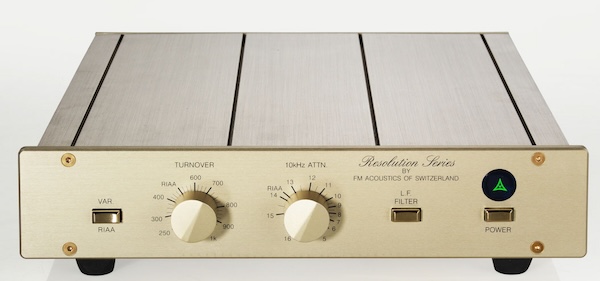
FM 122-MKII Phono Linializer. photo from FM ACOUSTICS of Switzerland website.
つまり、1980年代当時、78回転盤マニア向けに $300 で販売されていた Owl 1 では、コストをおさえるためにターンオーバーの選択肢を多くはしなかった、そして、78回転盤再生が主たるターゲットだったために、400Hz ターンオーバという特殊な値にはこだわらなかった、というあたりではないでしょうか。
In other words, the Owl 1, which was sold to 78rpm enthusiasts for $300 in the 1980s, did not offer many turnover positions to keep costs down, and since 78rpm playback was its primary target, it was not concerned with the special 400Hz turnover value. It is my guess though.
20.2.2 Notable Resources (2): MidiMagic
現在「英語圏で」オンラインで流通しているRIAA以前のカーブ一覧表は、「試聴のみで判断しない」「可能な限り客観的情報を論拠とする」というスタイルで公開されています。同時に、「その説の出典や論拠を明記する」「複数説がある場合は併記する」ようにで公開されているものがあります。これは建設的な議論を行い、継続的に調査研究をしていく上で、とても大事なことです。
Many of the pre-RIAA curve lists currently circulating online “in the English-speaking world” are published in a style that “does not make judgements based sorely on listening” and “uses objective information as much as possible as arguments”. At the same time, some of them are published in such a way as to “clearly state the sources and arguments for the theory”, and “list multiple theories, if any”. This is very important for constructive discussion and ongoing research and study.
そして、対象があくまで1950年代後半までである、つまり、ステレオ時代は(Deutsche Grammophon などごく一部の例外を除いて)問答無用にRIAAである、というまっとうな前提で情報がまとめられているのも、当然ながら好感が持てます。
And, of course, I like the fact that these information is compiled under the honest assumption that the subject matter is only up to the late 1950s, i.e. the stereo era is RIAA without question (with a very few exceptions, such as Deutsche Grammophon).
例えば、レコードチェンジャー機に関する膨大な資料を公開されている Larry Robinson 氏のサイト MidiMagic に、ディスクEQカーブに関して平易かつ丁寧に解説されたページ「HOW TO EQ OLD RECORDS」があります。
For example, Mr. Larry Robinson’s website MidiMagic, which has published a vast amount of information on record changers, has a page “HOW TO EQ OLD RECORDS”, explaining disc EQ curves in a simple and detailed manner.
このページの下には、知られている全カーブのバリエーション や、どのレーベルがいつまでどのカーブを使っていたと考えられるかの一覧 があります。
At the bottom of this page, you will find a list of all known curve variations and a list of which labels are believed to have used which curves and for how long.
しかし、このページでは、出典が明記されていません。記載されている情報から判断すると、恐らくは、過去の「Dialing Your Disks」や James R. Powell 氏の記事、さらには以下で触れるサイトの情報などをもとに、ご自身の考えを加味して構成されたものなのでしょう。
However, this page does not clearly state the source of the information. Judging from the information provided, this page was probably constructed by adding his own ideas based on past articles such as “Dialing Your Disks” and James R. Powell’s article, as well as information from the sites mentioned below.
20.2.3 Notable Resources (3): PsPatial
アップサンプリング、ノイズリダクション、イコライズなど多様な機能を備えた Mac 用のオーディオソフトウェア Stereo Lab をリリースしている、Pspatial Audio のサイトには、多種多様な圧巻のコンテンツが満載です。Alastair MacMaster & Richard Brice の両氏によってメンテされているサイトです。
Pspatial Audio, which releases Stereo Lab, audio software for Mac that offers upsampling, noise reduction, equalization and much more, has an impressive variety of content on its site, maintained by Alastair MacMaster & Richard Brice.
ディスクEQカーブに関する考察も、試聴のみに基づく主観的判断ではなく、論文や回路図、取説、その他客観的資料に基づいた客観的判断と論理的帰結、残る疑問を細かく紡いでいます。録音アンプやカッティングレース、カッターヘッドの議論もしっかり行われています。
The discussion of disc EQ curves in this website is also not a subjective judgment and logical conclusion based on papers, schematics, instruction manuals, and other objective materials, and the remaining questions are discussed in detail. Recording amplifiers, cutting lathes and cutterheads are also well discussed.
2022年夏に、私が初めて上のページを読んだ時、「Dialing Your Disks」方式の単なる一覧表ではなく、過去の資料や論文にあたり、技術的考察を尽くした上で推奨カーブの議論を行っている姿勢に感銘を受けました。私が1925年にさかのぼって全てを学ぼう、そう思ったきっかけを与えてくれたサイトです。
When I first read the above pages in the summer of 2022, I was really impressed, because these pages were not just a “Dialing Your Disks” type of list, but were written with the attitude of discussing the recommended curves based on all the technical considerations in the past documents and papers. This is the site that inspired me to go back to 1925 and learn everything I could.
その上で、Pspatial サイトが公開している EQ カーブ一覧表は、PDF としてまとめられています。Stereo Lab ソフトウェアで適用可能なプリセット再生EQカーブ一覧と、各レーベルの推奨再生カーブ、いつ頃 RIAA カーブに変更されたと考えられるか、がコンパクトにまとめられています。出典は明記されていませんが、過去の資料などをもとにした独自成果ということなのでしょう。
The EQ curves table published by the Pspatial site has been compiled as a PDF document. It is a compact list of preset playback EQ curves that can be applied in Stereo Lab software, the recommended playback curves for each label, and when they are thought to have changed to RIAA curve. The source is not specified, but it is likely to be an original result based on past documents.
20.2.4 Notable Resources (4): Esoteric Sound Rek-O-Kut Re-Equalizer III Operating Manual
私も長年使用している、RIAAフォノイコと組み合わせて使うタイプのカーブ可変イコライザ Esoteric Sound Rek-O-Kut Re-Equalizer III の マニュアル (PDF) も、以前のものに比べてアップデートされており、かつ、上で紹介したサイトとは異なる側面から独自分析を行っているのが特徴です。
The Esoteric Sound Rek-O-Kut Re-Equalizer III, which I have used for many years, a variable curve equqlizer for use in combination with the RIAA phono equalizer. The manual (PDF) for the Re-Equalizer III has also been updated compared to the previous versions, and also features an independent analysis from a different aspect than the sites I mentioned above.
例えば、米 London (英 Decca)のマトリクス刻印で、「基本的にはマトリクス番号順に時期が決まる」「刻印文字が凸に盛り上がっているものは 500N-10.5」「刻印文字が凹になっているものは凸よりも新しい」「末尾に R がついているものは、古いマトリクス番号でも RIAA でリカットされたもの」(もちろん、R がついていないものが非 RIAA、という意味ではない)など、近年広く知られるようになってきた情報が、写真付きで解説されています。
For example, in the case of U.S. London (U.K. Decca), many information that has become widely known in recent years, is explained along with photos, including: “basically, the period is deteremined in order of the matrix number”; “record with raised matrix letters is 500N-10.5”; “record with engraved matrix letters is newer than the record with raised matrix”; “engraved matrix letter R at the end indicates that it was recut with RIAA, even if the matrix number is old” (of course, this does not mean that those without an R are always non-RIAA).
同様に、米 Decca についても、刻印が凸のもの(古い)と凹のもの(新しい)が比較されますが、マトリクスが MG2416T3 の盤が凸、MG2416T7 の盤が凹である実例写真(Decca DL-9594, Fritz Lehmann: Berlin Philharmonic Orchestra, 1951)を紹介しつつ、同じ MG2614 であっても T7 の後者が RIAA でリカットされたもの、としています。
Similarly, for the U.S. Decca, a comparison is made between a disc with a raised matrix (old) and a disc with a engraved matrix (new). The author introduces one interesting example (Decca DL-9594, Fritz Lehmann: Berlin Philharmonic Orchestra, 1951), with the photos of MG2416T3 matrix and MG2416T7 matrix, and states that the latter T7 is recut with RIAA, even though the main matrix number is the same MG2416.
Columbia についても、最も古いパターンである、大きな字母で凸のマトリクス刻印、その後一般的になる縦長のフォントで凹のマトリクス刻印が写真付きで紹介され、さらに具体例(Columbia ML-4729, Eugene Ormandy: Philadelphia Orchestra, 1954) において、マトリクス刻印 XLP12872-1A は Columbia LP カーブ、XLP12872-1D は RIAA カーブでリカットされたもの、としています。その他、「HiFi+」ステッカーが加貼されている盤も RIAA でのリカットの可能性がある、という興味深い議論も行われています。
For Columbia, the earliest matrix pattern of large raised letters, followed by the next pattern of vertically long engraved letters which became more common later, are presented with photos. And for the example (Columbia ML-4729, Eugene Ormandy: Philadelphia Orchestra, 1954), the author describes that the disc with the matrix XLP12872-1A was cut with Columbia LP curve, while the disc of XLP12872-1D was recut with RIAA curve. There is also an interesting argument that the “HiFi+” sticker may also be a RIAA recut.
この Re-Equalizer III のマニュアル PDF で提示されるカーブ一覧表は、一部不思議な内容もありますが、このように「マトリクス番号の特徴から時期を推定する」「同じマトリクス番号でも枝番が違うと、機器変更タイミングをまたいだ場合、別特性でリカットされていることになる」という点は、論理整合性からみても非常に納得感のある説だと感じます。これらを参考に、個々のレーベルについて、大量の盤の情報をかきあつめて網羅的に調査したら、いろんな新しい発見ができそう、そんな期待を持たせる情報源です。
The vast list of curves presented in the Re-Equalizer III manual PDF has some strange information, but I feel that this “estimating the timing based on the characteristics of the matrix numbers” and “if the same matrix number has different branch numbers, and if the eqipment change timing is crossed, two discs would be cut with different EQ curves” are very convincing theories from the standpoint of logical consistency. I believe this is a source of information that gives us hope that if we were to gather information on a large number of individual labels and conduct a comprehensive survey, we would be able to make a variety of new discoveries.
20.2.5 Notable Resources (5): Audacity Plugins
Mac, Windows, Linux とマルチプラットフォーム対応、有名な音声編集ソフト Audacity にも、フィルタカーブ エフェクト機能があり、フラットにディジタル録音されたレコード音源に対して再生EQカーブを適用することが可能です。
Audacity, a famous sound editing software for Mac, Windows and Linux, also has a filter curve effect feature, that allows you to apply a playback EQ curve to a digitally recorded “flat” sound source.
この Filter Curve EQ 機能の解説ページ「Playback equalization for 78 rpm shellacs and early 33⅓ LPs」が、現時点で最も理想的な形態の情報源だと感じます。上述の MidiMagic や Pspatial などを含め、過去の情報を参照しつつ、「その説の出典や論拠を明記する」「複数説がある場合は併記する」スタイルで、しかも現在進行形でアップデートされ続けているのです。
I feel the page “Playback equalization for 78 rpm shellacs and early 33⅓ LPs” is the most ideal form of information source at this time. It is constantly updated in a style that “clearly states the source and rationale for the theory” and “lists multiple theories, if any” while referencing past information, including Mildmagic and Pspatial mentioned above, and it continues to be updated on an ongoing basis.
「複数説がある場合は併記」されているのがとても重要で、現在流通している各種の説をメタ分析できるような仕掛けになっています。そして「あるEQカーブに同意できない場合は、一覧にある別の候補を試し、自分の耳を信じて選択する必要がある」と書かれてあります。とても実直なスタイルです。
It is very importatnt to note that, if there is more than one candidate for a particular label, they are listed together, because this style allows us meta-analysis of the various theories currently in circulation. It then says, “In case sources did not agree on one EQ curve, their different opinions are listed and you will have to trust your ears”. I think it’s a very honest style.
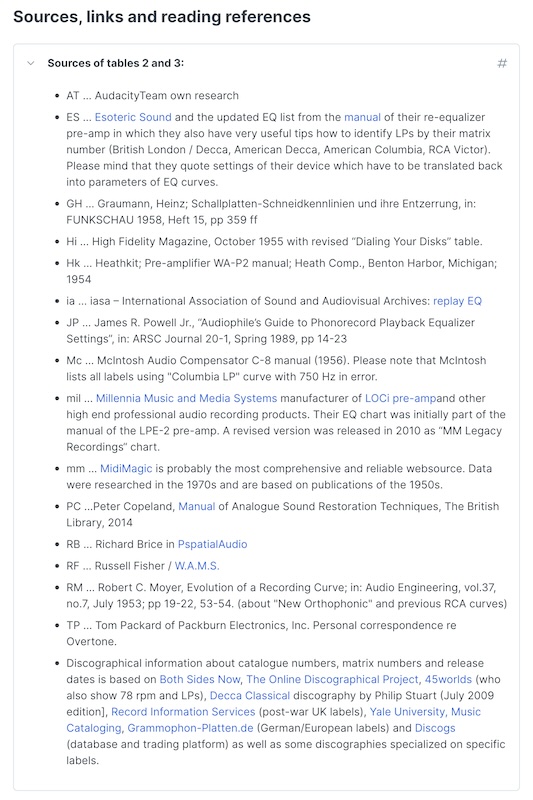
Sources, links and reading references, Pspatial website.
Audacity Plugins の EQ カーブ一覧表が論拠としている出典一覧
ここに列挙されているものはほぼ全て探して読み込みました(笑)
なお、本稿 Pt.0 でちらっと紹介した Gold Note PH-1000 フォノイコですが、その取説に付属する「EQ Curves Parameter Setup」の一覧表は、Audacity Plugins サイトのコピペ(笑)となっており、また、その旨の記載がありません。
As a side note, The Gold Note PH-1000 phono preamp, which was briefly introduced in Pt.0 of my article, comes with the document “EQ Curves Parameter Setup”, which is a copy-and-paste from the Audacity Plugins site 🙂 and there is no mention of this.
20.3 Meta-analysis of past/present resources is needed (preface to Pt. 21)
Re-Equalizer III マニュアルでの、マトリクス刻印と枝番から読み解こうとする取り組み。Pspatial サイトでの、技術史をおさえた飽くなき探究。Audacity プラグインサイトでの、出典提示と複数説併記のスタイル。これらの情報を足がかりにすることによって、いまだに正確な全貌が判明していない(= 正確な全貌を判明しようがない) RIAA 以前の推奨再生EQカーブと RIAA への変更時期の調査や議論のスタートポイントに立てる、そんな貴重な示唆を与えてくれます。
The Re-Equalizer III manual’s efforts to decipher the matrix / suffix numbers; the Pspatial site’s relentless exploration of the history of the recording technology; the Audacity Plug-In site’s style of presenting sources and multiple theories. These are all valuable pointers that can be used as a starting point for researching and discussing the pre-RIAA recommended playback EQ curves and the timings of the change to RIAA, which is not (and will not be) known in its entirety.
信頼性が高い出典や独自研究を元にして、まっとうなスタンスで継続的にオープンな調査が行われている、と考えられる代表的な情報源は上でみてきた通りですが、その他にも情報源は過去〜現在にいくつかあるようです。
The above is a representative list of sources that can be considered to be based on reliable sources, original research, and an honest stance of ongoing open research, while there are several other sources of information, past and present.
この先は、これらが論拠としている過去の論文、技術解説記事、その他の資料とあわせて、それぞれのレーベルについて個々人が調査し、深掘りしていくしかないでしょう。特に、上記サイトであっても、一部のデータは明らかな間違いと考えられるものがあります。例えば、Pt.17 セクション 17.3 でみたように、Reeves Sound Studios マスタリングの最初期(1949年〜1950年)の Mercury LP は、AES カーブに移行する前は NAB カーブを使っていた可能性が高いが、すべてまとめて AES とのみ表記されている、などです。
Beyond this, it will be up to each individual to investigate and dig deeper into each label, along with the past papers, technical commentary articles, and other documents on which they base their arguments. In particular, some of the data, even from the above sites, can be considered obvious errors. For example, as seen in Pt.17 Section 17.3, Mercury LPs from the earliest period of Reeves Sound Studios mastering (1949 to 1950) were most likely using the NAB curve, before moving to the AES curve, but all the above sites lists pre-RIAA Mercury as AES only.
そういった面も含めて、世界中の探究者による共同作業と情報共有によって、これらの情報が編纂され、アップデートされ続けていることは、とても喜ばしいことです。
With that aspect in mind, it is gratifying to see that all the information continues to be compiled and updated through collaboration and information sharing by inquirers around the world.
20.4 The summary of what I got this time / 自分なりのまとめ
この連載記事もそろそろ終盤になりました。本当は、ステレオ録音の歴史と VL vs 45-45 の経緯、1964年のNAB「再生」特性、その後の RIAA-IEC や eRIAA、さらに DMM などの話まで踏み込みたかったのですが、それは今後の課題として、電気録音黎明期からRIAAカーブ成立までの歴史を追っただけでこれだけのボリュームになってしまい、多くの学びがありました。
We are almost at the end of the series of articles. I really wanted to go into the history of stereo recordings and the history of VL vs 45-45, 1964 NAB “Playback” Characteristics, and the subsequent RIAA-IEC, eRIAA, and even DMM, etc., but that is the subjects for the future. I have learned a lot from just following the history from the dawn of electrical recordings to the establishment of the RIAA curve, which turned out to be a lot of volume.
さてさて、今回の内容をざっくりまとめると、こんな感じでしょうか。
…so, the rough summary of my understanding in this Pt.20 article would be something like this:
RIAA規格策定前に、RIAAと同一録音特性を使っていたレーベルは、RCA Victor、Capitol、そして両者に製造委託していたマイナーレーベルだけだった。
Prior to the establishment of the RIAA Standard, the only labels that used the same recording characteristics as RIAA were, RCA Victor, Capitol and minor labels that outsourced their production to RCA and/or Capitol.
1954年8月時点で、Columbia では RIAA への変更が済んだスタジオ設備は全体の半数以下で、全設備の移行完了はそこからまだ半年以上かかる、とニュース記事が伝えていた。
As of August 1954, only less than half of Columbia’s studio facilities had been converted to RIAA, and it would take another six months or more before the entire transition was complete, according to the news article.
唯一、Westminster レーベルだけが、RIAA へ移行せず、旧NABカーブのままでいく、と1954年8月時点で同記事中で明言していた。
Only the Westminster label stated in the same news as of Aug. 1954 that it would not move to the RIAA and would remain on the old NAB curve.
Rudy Van Gelder 氏本人が「自分は RIAA 特性を使用している」と発言している、1955年10月のインタビュー記事がある。使用機材からも説明できる。
There is an interview from October 1955 in which Rudy Van Gelder himself states that he uses the RIAA characteristics. The equipment he used proves this.
現在、さまざまなEQカーブ一覧表の情報が流通しているが、信頼できるものは「過去の論文や技術資料を参照している」「出典を明らかにしている」「過去の一覧表を比較しながら横断的に分析している」などの特徴があると考える。
Currently, variations on EQ curve listing are circulating, but I believe that reliable ones are characterized by “referencing past papers and technical documents”, “clarifying the source”, and “cross analysis by comparing past listings”.
実際に各録音で使用された録音EQカーブが完璧に特定できない以上、さまざまな客観的情報や論理的整合性に基づいた推論をもとに、個々人が探究していくしかない。
Since the actual recording EQ curves used in each recording cannot be perfectly identified, it is up to each individual to explore them based on various objective information and inferences based on logical consistency.
同時に、個々人が思い思いのカーブで再生することは自由である(それが客観的に正しいカーブでなかったとしても)。
At the same time, each individual is free to play with the curves as he/she sees fit (even if the curve selected is not objectively correct).
次回の Pt.21 が最終回(の予定)で、LRC vs RC の話題に触れたのち、これまで学んできたことを総動員して、米国の各レーベルで最終的に RIAA に移行が完了したのはいつと考えられるか、そして、特に日本で見かけられるさまざまな説についての考察を行いたいと思っています。
In the next Pt. 21 (which will probably be the final part), I will mention the topic of “LRC vs RC”, then I would like to mobilize everything I have learned so far and discuss when the transition to RIAA was finally completed for each label in the U.S., and the various opinions that I have seen, especially in Japan.
» 続き / Sequel: “Things I learned on Phono EQ curves, Pt.21” »


